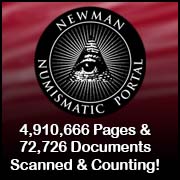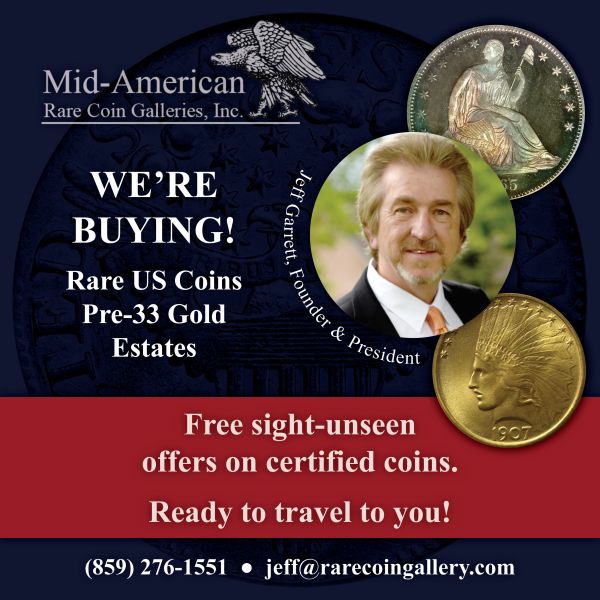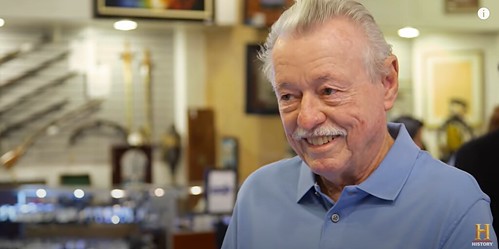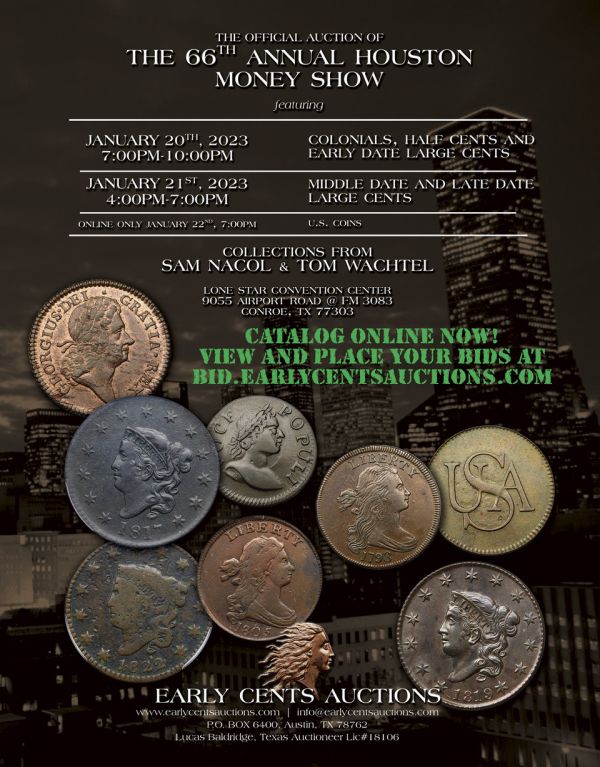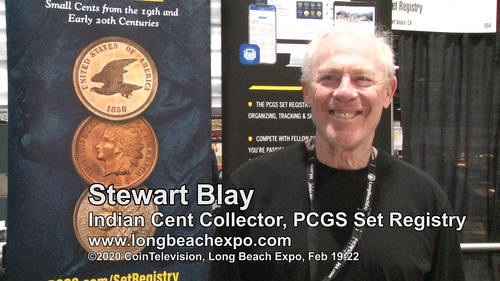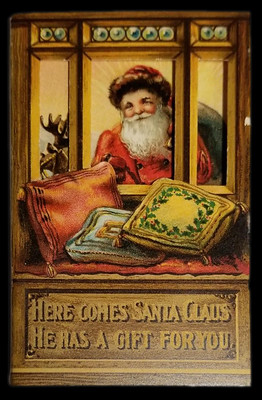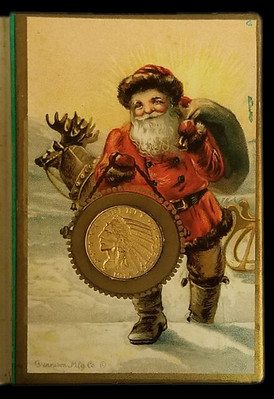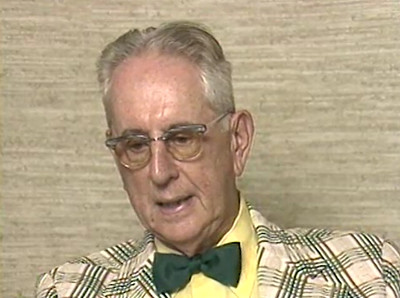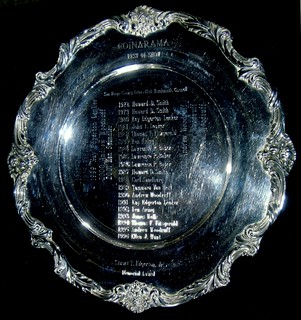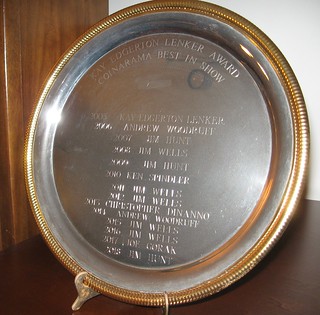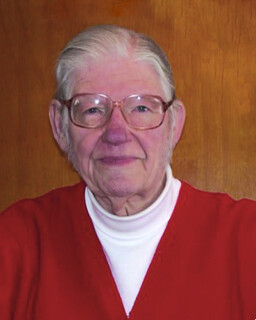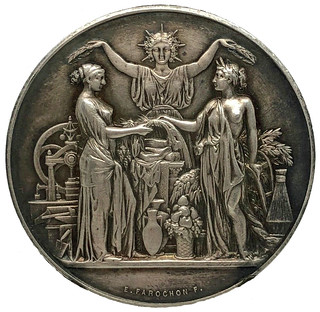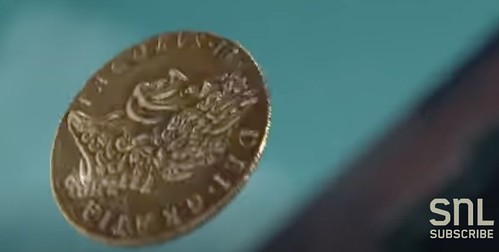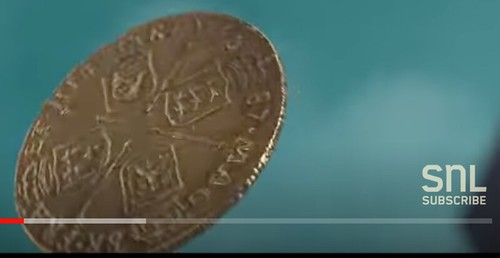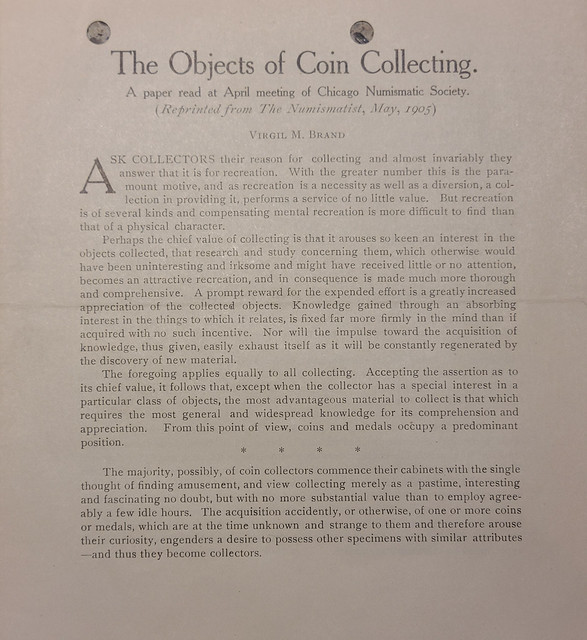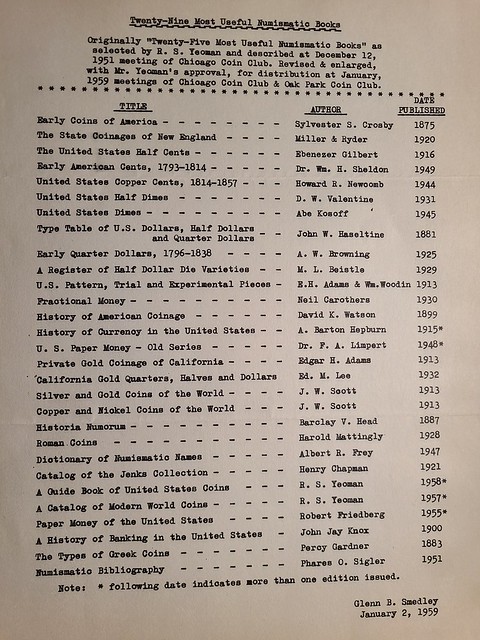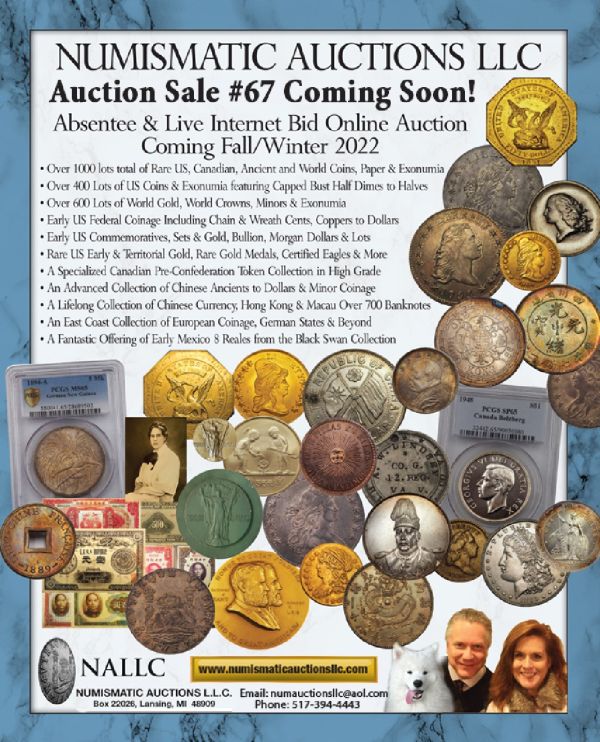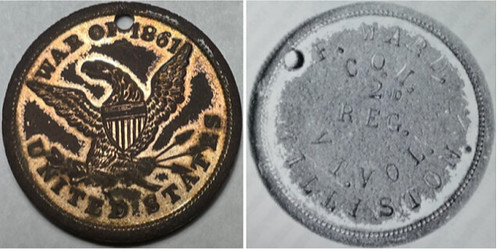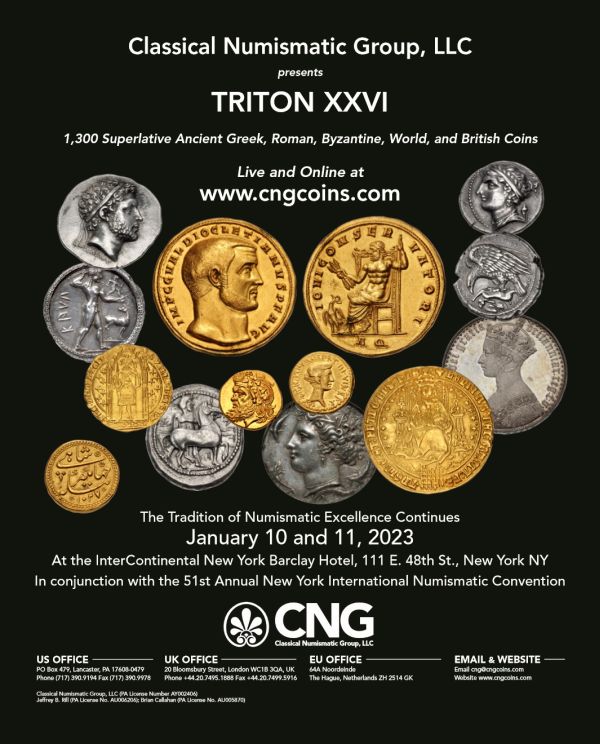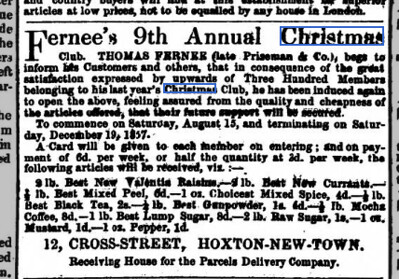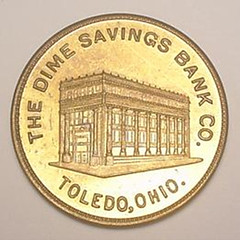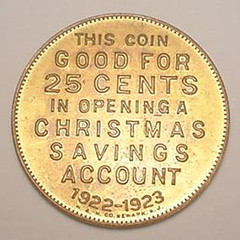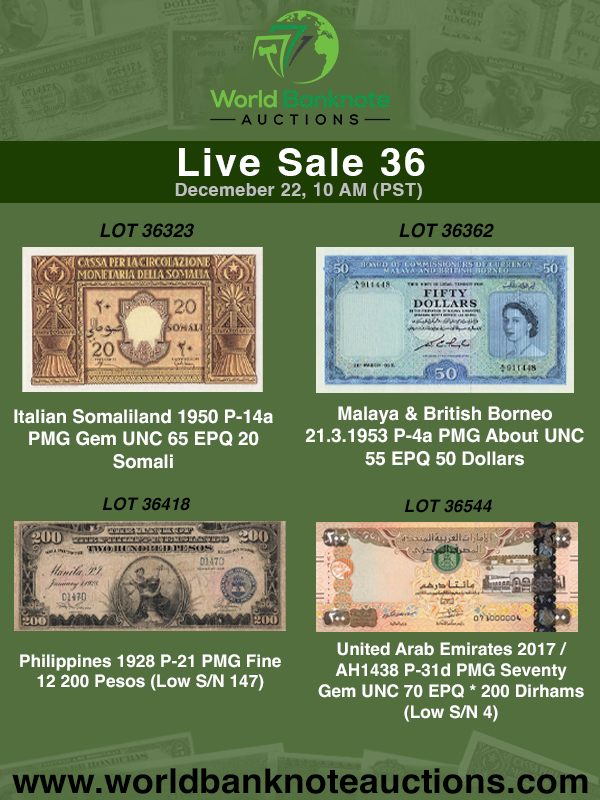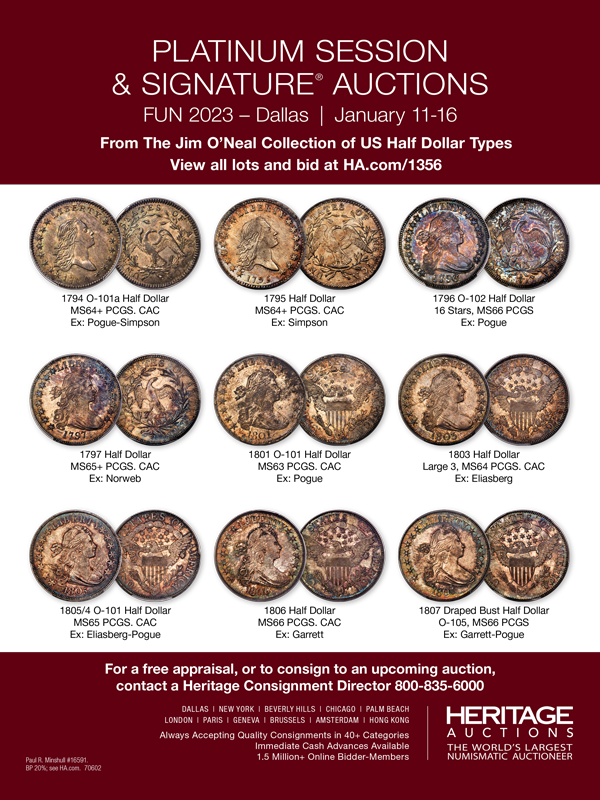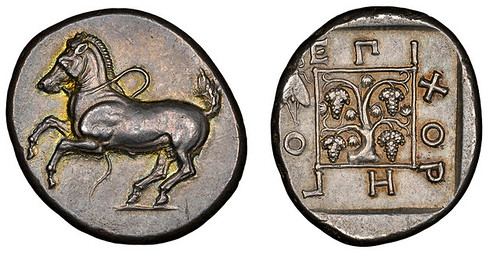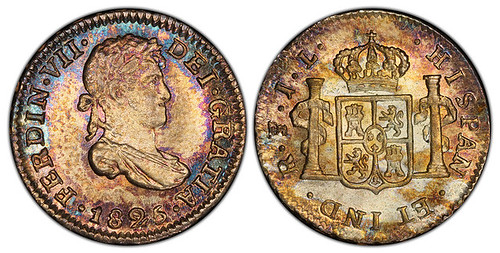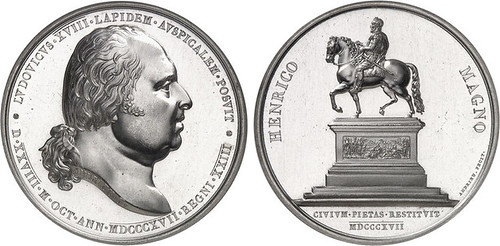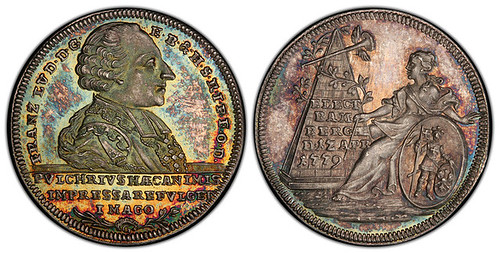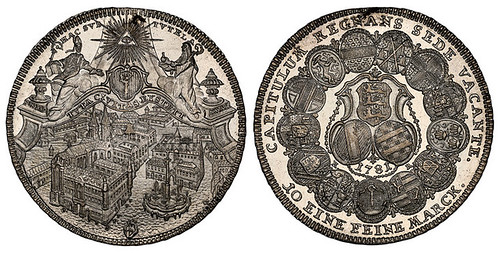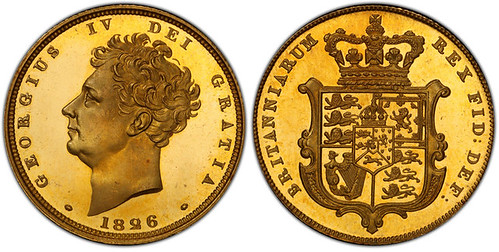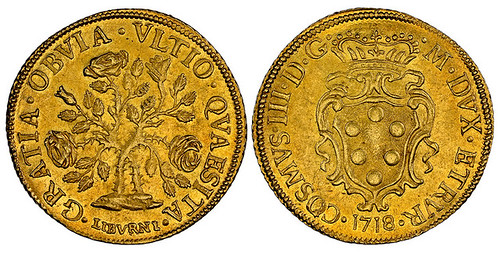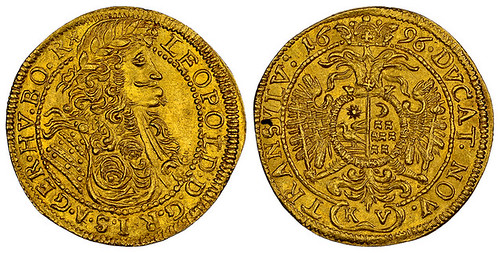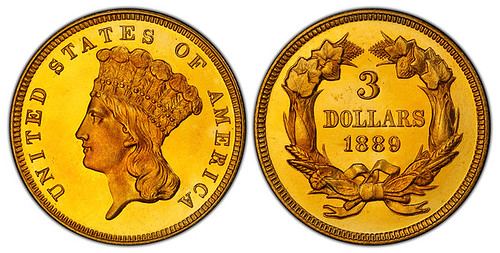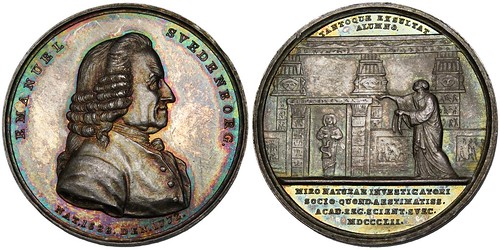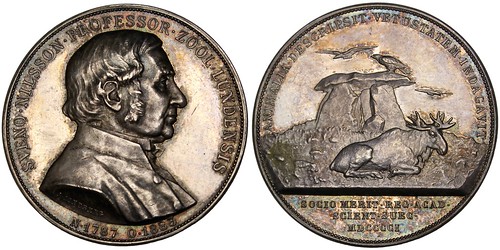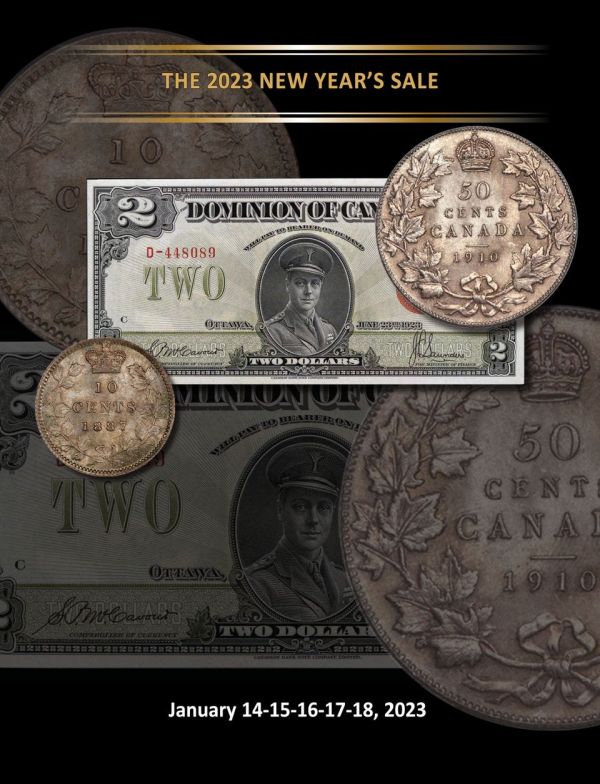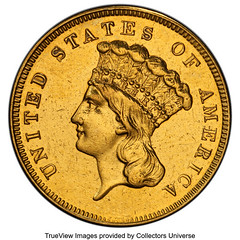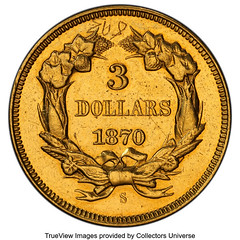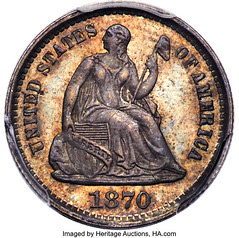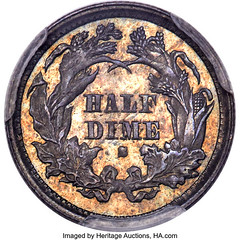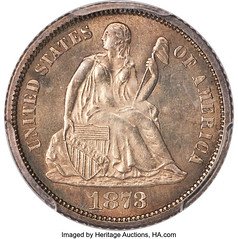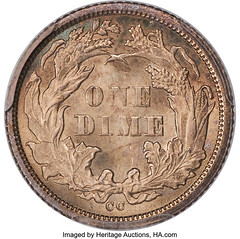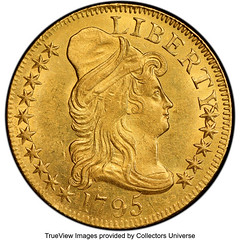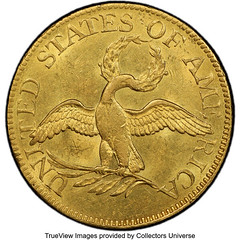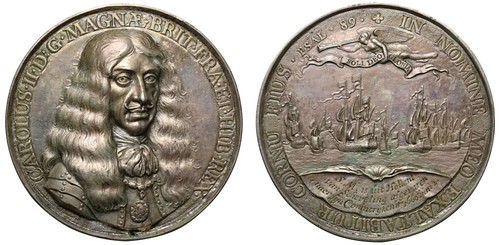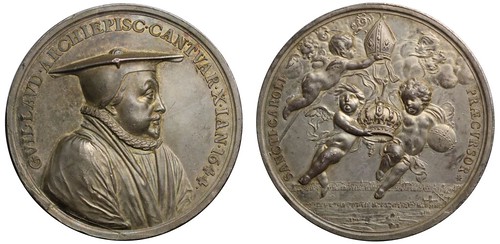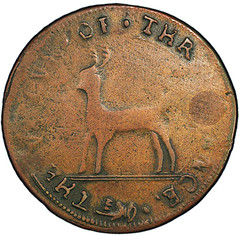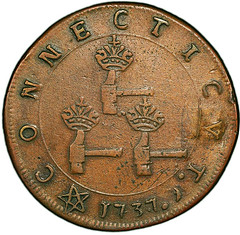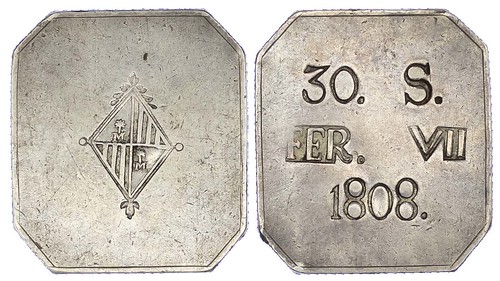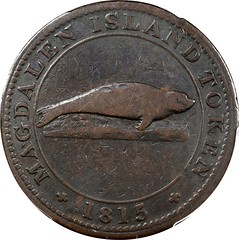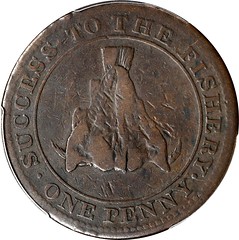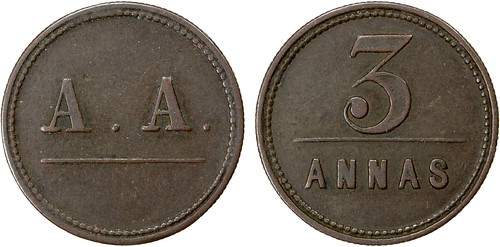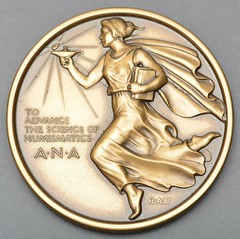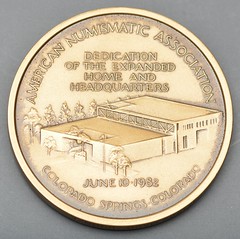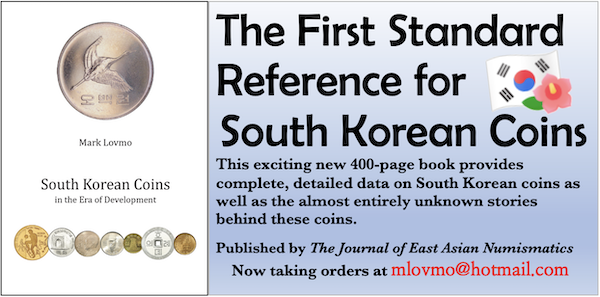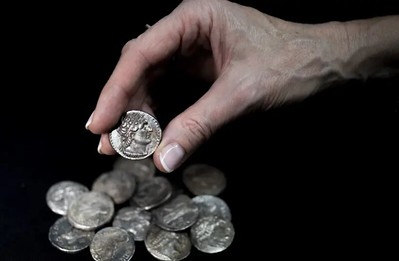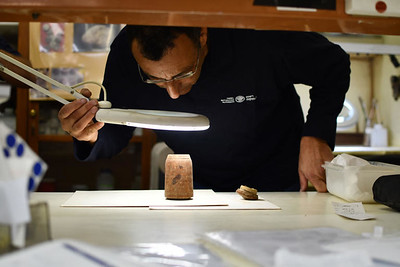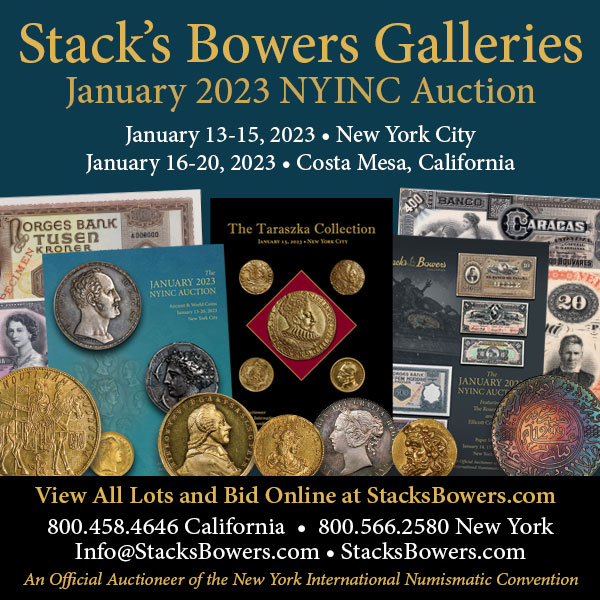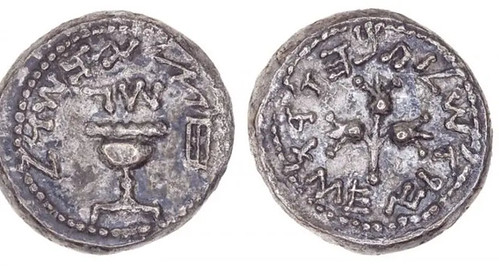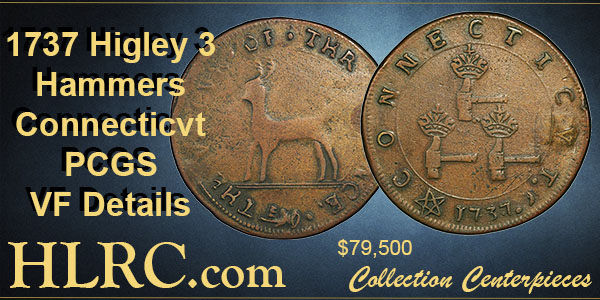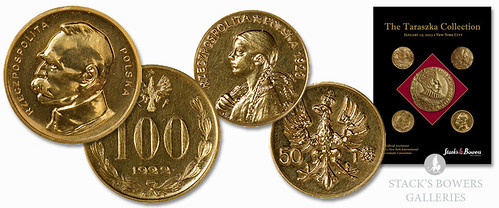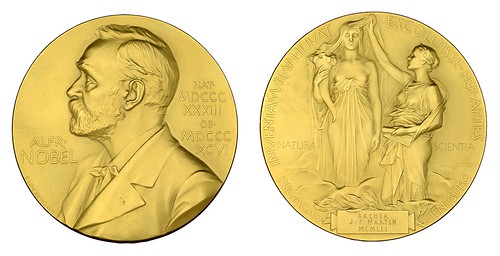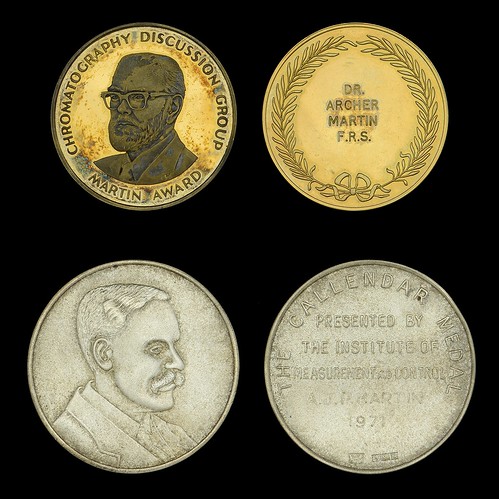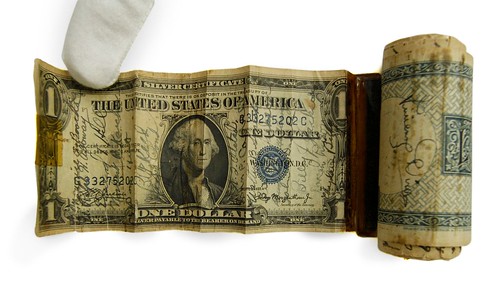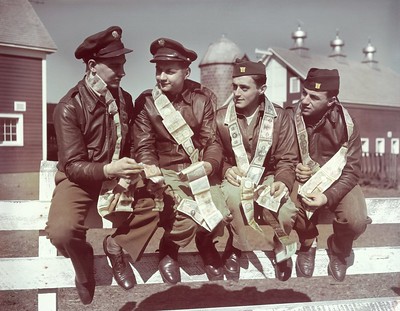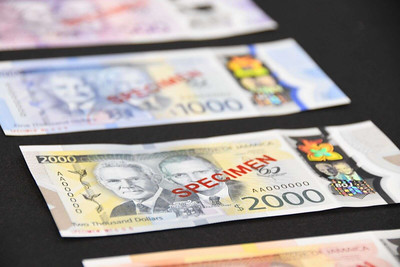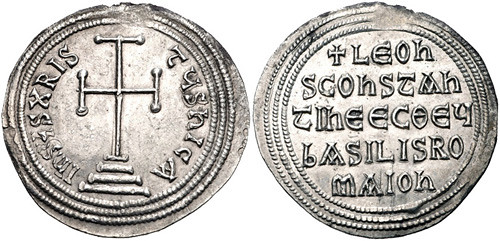
Visit our NBS Sponsors




About UsThe Numismatic Bibliomania Society is a non-profit association devoted to the study and enjoyment of numismatic literature. For more information please see our web site at coinbooks.org SubscriptionsThose wishing to become new E-Sylum subscribers (or wishing to Unsubscribe) can go to the following web page link MembershipThere is a membership application available on the web site Membership Application To join, print the application and return it with your check to the address printed on the application. Print/Digital membership is $40 to addresses in the U.S., and $60 elsewhere. A digital-only membership is available for $25. For those without web access, write to: Charles Heck, Treasurer AsylumFor Asylum mailing address changes and other membership questions, contact Chuck at this email address: treasurer@coinbooks.org SubmissionsTo submit items for publication in The E-Sylum, write to the Editor at this address: whomren@gmail.com BUY THE BOOK BEFORE THE COINSale Calendar |
- WAYNE'S WORDS: THE E-SYLUM DECEMBER 18, 2022
- ORIENTAL NUMISMATIC SOCIETY WINTER 2023
- WALTER J. HUSAK (1942-2022)
- STEWART BLAY (1950-2022)
- A COIN GIFT CHRISTMAS CARD
- VIDEO: ELDRIDGE JONES
- CHATGPT AND NUMISMATICS
- NOTES FROM E-SYLUM READERS: DECEMBER 18, 2022
- VIRGIL BRAND: THE OBJECTS OF COIN COLLECTING
- MOST USEFUL NUMISMATIC BOOKS OF 1959
- FRANK WARD CIVIL WAR DOG TAG
- CHRISTMAS CLUB TOKENS
- VOCABULARY TERM: MEDALLIC ART
- NUMISMATIC HALLS OF FAME
- BAUMAN BELDEN OF THE ANS
- HARRY LAIBSTAIN ON HOBBY'S PAST AND FUTURE
- CENTRAL STATES EXPANDS 2023 CONVENTION
- ATLAS NUMISMATICS DECEMBER 2022 SELECTIONS
- NUMISMAGRAM SELECTIONS: DECEMBER 18, 2022
- HERITAGE BASS II COLLECTION SELECTIONS
- NUMISMATIC NUGGETS: DECEMBER 18, 2022
- HASMONEAN MUSEUM MACCABEAN COIN DISPLAY
- HALF-SHEKEL FROM THE GREAT REVOLT DISCOVERED
- POLISH MARK-DENOMINATED GOLD COINS
- ARCHER MARTIN NOBEL PRIZE IN CHEMISTRY
- HOW TO SPOT A ‘SHORT SNORTER'
- NEW NIGERIAN BANKNOTES ENTER CIRCULATION
- JAMAICA LAUNCHES NEW BANKNOTES
- THE GREAT BOOK DEACCESSION
- LOOSE CHANGE: DECEMBER 18, 2022
- INTAGLIO AUTO TITLE PAPER SHORTAGE
Click here to read the thin version on the web
Click here to subscribe
Click here to access the complete archive
To comment or submit articles, reply to whomren@gmail.com
Content presented in The E-Sylum is not necessarily researched or independently fact-checked, and views expressed do not necessarily represent those of the Numismatic Bibliomania Society.
WAYNE'S WORDS: THE E-SYLUM DECEMBER 18, 2022
 Thank you for reading The E-Sylum. If you enjoy it, please send me the email addresses of friends you think may enjoy it as well and I'll send them a subscription. Contact me at whomren@gmail.com anytime regarding your subscription, or questions, comments or suggestions about our content.
Thank you for reading The E-Sylum. If you enjoy it, please send me the email addresses of friends you think may enjoy it as well and I'll send them a subscription. Contact me at whomren@gmail.com anytime regarding your subscription, or questions, comments or suggestions about our content.
Thanks to Hugo Vanhoudt of Belgium for sending a holiday greeting.
This week we open with a special anniversary journal issue, two obituaries, updates from the Newman Numismatic Portal, numismatic poetry, and more.
Other topics this week include the American Numismatic Association, Virgil Brand, Bauman Belden, the most useful numismatic books, Christmas Club tokens, medallic art, numismatic Halls of Fame, fixed price and auction previews, coin finds from Israel, short snorters, new banknotes, and the great title paper shortage.
To learn more about the Private Cash of Ancient Annam, coin gift Christmas cards, Eldridge Jones, Dick Johnson, Walt Husak, the Numismatic Poets Society, Civil War dog tags, Life-Saving medals, the Maroneia Stater, the 1873-CC No Arrows Seated Dime, the Nobel Prize in Chemistry medal, and coins of the Iconoclasts, read on. Have a great week, everyone!
Wayne Homren
Editor, The E-Sylum
ORIENTAL NUMISMATIC SOCIETY WINTER 2023
The Winter 2023 issue of the Journal of the Oriental Numismatic Society marks the publication's 250th issue and the society's 50th birthday. Editor Dr. Paula Turner passed along this announcement. Thank you. -Editor
A Letter from Your Secretary General
Dear ONS members,
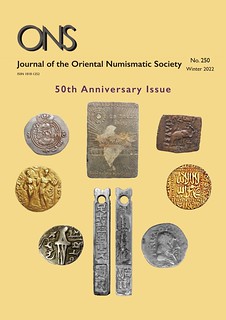 It brings me great pleasure to introduce you to this special 50th Anniversary Conference issue of the Society's journal. This double issue is also fittingly the 250th volume of the journal and its antecedents.
It brings me great pleasure to introduce you to this special 50th Anniversary Conference issue of the Society's journal. This double issue is also fittingly the 250th volume of the journal and its antecedents.
As many of you no doubt remember, the Society celebrated its 50th anniversary in 2020 and the conference was originally scheduled to be held in April of that year. Of course, you all know what happened next. The pandemic forced a postponement to 2021 and then, when the pandemic had not yet abated by April of that year, another postponement to 2023. Early this year, there was still a lot of uncertainty about whether things would open up and permit international travel to take place in earnest. The Council decided not to risk the need for another postponement and opted to commit to hold the conference via Zoom only.
Spread over two half-days, to allow more people worldwide to attend, the Conference was held on 25 and 26 June. It brought together speakers from eight countries and covered a wide range of areas within the purview of the Society. There were two keynote speakers, John Deyell and Dai Jianbing, and ten other speakers. Joe Cribb, who organized the conference, also gave a brief historical retrospective on the Society. All but two of these talks are published here in full; many of them are also available as video recordings on the Society's YouTube channel. (If you are not already a subscriber, I urge you to subscribe: just search for Oriental Numismatic Society on YouTube).
Pankaj Tandon, Secretary General of the Oriental Numismatic Society
CONTENTS
Letter from Your Secretary General
Pankaj Tandon
Fifty Years of the Oriental Numismatic Society
Joe Cribb
On Attribution: Interpretative challenges in Indo-Sasanian
(and other) coinages
John S. Deyell
Recent Developments in Chinese Numismatics
Dai Jianbing
The Circulation and Use of Bamboo Tallies in Jiangsu Province
with Particular Reference to the Tongcheng Company Issues
François Thierry
Cataloguing the Private Cash of Ancient Annam
François Joyaux
Fresh Light on the Copper Coins of the Vemakis
Amiteshwar Jha
The Evidence of Gold Content for the Attribution of the Coins
in the Name of Candragupta
Pankaj Tandon
From Bishapur to Vienna: A note on a hoard of late Sasanian drachms
Ehsan Shavarebi
Immobilized Types in Sogdian Coinage: The case of mules between Antiochus imitations and Hyrcodes
Aleksandr Naymark
Mints and Urban Dynamics: Baghdad, al-Raqqa and other places
Stefan Heidemann
Badshah as the Caliph: Probing caliphal pretensions of the
Mughal rulers of India
Sanjay Garg
A Biography in Banknotes: The life and career of Alfred Joseph Bull, 1876–1950
Richard Morel
Bombay Tolas
Michael Mitchiner
For more information, see:
https://www.orientalnumismaticsociety.org/
WALTER J. HUSAK (1942-2022)
Pete Smith submitted this note on Large Cent collector Walt Husak, who passed away this week. -Editor
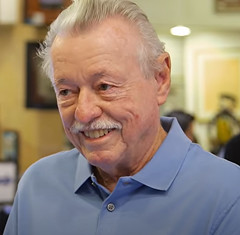 Walt Husak died late in the afternoon of Thursday, December 15, 2022. Within hours, his friend
Al Boka sent out a notification to other friends and fellow collectors around the country. Soon
tributes were coming in from many of them.
Walt Husak died late in the afternoon of Thursday, December 15, 2022. Within hours, his friend
Al Boka sent out a notification to other friends and fellow collectors around the country. Soon
tributes were coming in from many of them.
Walter Joseph Husak was born in Chicago on May 27, 1942. His parents were Walter and June Blake Husak. At the time of the 1950 Census, they were living in Los Angeles with the father listed as a salesman for a sign company and the mother as a waitress in a restaurant. Later in the 1950's, Walter was a teller at the Merchants National Bank in Cedar Rapids, Iowa.
Walt began collecting Lincoln cents and Buffalo nickels when he was twelve. While on a visit to his grandparents' Iowa farm, he was given a few old coins for doing chores.
A boy's coin collection may not survive when his interest turns to girls or cars. Walt got married and had a child. His collection was sold so he could buy a 1957 Triumph sports car. Nine months later in 1963, with his second child expected, he sold the Triumph to buy a more practical family car, a 1954 Cadillac convertible.
Walt's first marriage to Irene Catherine Ferris produced a son, Wally, and daughter, Trina, and ended in divorce in 1967. With his second marriage to Patricia, he added her children to his family.
In 1959, Walt began work in the aerospace industry. After working for others for twenty years, he took a chance with his own business and became successful. Husak had various corporate interests in the aerospace industry. He is listed as president of W & T Holdings, Inc. (1984); Hk Aerospace, Inc. (1992); and W & M Property Management Corp. (2013).
Walt ran the Los Angeles Marathon six times and finished four times. While on a training run in 1988, he passed a gas station and noticed a familiar car for sale, his old 1954 Cadillac. He bought it a second time and had it restored for pleasure trips in the California wine country. His drive to collect returned in 1980 when he acquired an 1804 large cent. This casual interest in large cents grew and he aspired to complete a set of 1793 to 1814 large cents by Sheldon variety.
This would be a total with edge varieties of 302 pieces. He succeeded in getting all but the S-15, S-79 and S-80. The known examples of those were held in strong hands and not available. He selected coins in choice condition or coins with great pedigrees or both. Those coins that are not the finest known were often high in the condition census.
Walt was an excellent photographer who documented his own collection while it was raw. He also documented raw coins for Alan Weinberg.
Husak was an active participant in Heritage, Goldberg and Stack's auctions as he was building his collection. As a good client, they reserved bidder number 94 for him. He returned to Heritage when it was time to sell. With his collection stalled and real estate debts to pay, he consigned his collection to Heritage for auction on February 15, 2008. The collection was legitimately described as the finest collection of early large cents ever offered at public auction.
Heritage produced a colorful forty-page prospectus to create interest in the sale and that interest brought in collectors from around the country. The auction catalog included 301 lots and 414 pages with a full page devoted to each coin and color photo. Cataloguing was done by Mark Borckardt with additional commentary by Denis Loring. On the day of the sale the auction room was packed with 200 potential bidders. The Husak collection was dispersed among 168 successful bidders.
At the sale, two large cents each sold for $632,500. They were lot 2014, a 1793 Liberty Cap cent, S-13, PCGS AU-50, and lot 2050, the finest known Starred Reverse cent, S-48 PCGS AU-50. Lot 2192 was the famous 1799 Abbey cent
pedigreed back to an 1864 sale of coins of Lorenzo
Abbey. It sold for $161,000. The sale realized about $10.7 million which was about double the
cost to assemble the collection.
After the sale he established the charitable Liberty Cap Foundation. He is listed as CEO with Martin A. Logies as agent. This presents a virtual museum for his collection. He was not done collecting but started over specializing in the cents of 1794. By 2022 his was the finest current collection and third behind Naftzger and Sheldon for historical collections. No trades with the ANS were required for the formation of his collection.
Walt appeared in an episode of the Reality
TV show, Pawn Stars, that aired on January 29, 2018. He offered a 1792 half disme for sale identified as the Garrett specimen in a PCGS MS-65
holder. The boys in the shop declined to pay the asking price. A different Garrett, Jeff Garrett
was also called in as an expert.
Viewers of the show may be aware that some of the scenarios are contrived and set up in advance. Husak did not own the coin at the time. It had been in unsold inventory for Steve Contursi and Rare Coin Wholesalers.
Following his death, tributes flowed in from friends he had made in the hobby. There was no unkind word to be said about him.
Chuck Heck writes:
"Walt Husak was born on May 27, 1942 and he passed away this week on December 15. He and I met over a coin at an auction in 1997. Obviously, I was the under-bidder. However, both my wife and I received something much more precious than an addition to the coin collection -- we received an incredible 25 year friendship with Patricia and Walt Husak.
"Friendship is a cool word. It can cover a very broad range of experiences. It was coins that brought us together but it was the love for living a life with joy that defined our times spent together.
"Unfortunately, while in the hospital, his gentle heart simply gave out.
"To a GIANT of a friend, a glass of very old single malt scotch held very, very high."
Jim Neiswinter writes:
"Walter was one of the nicest people I've ever met. He was a people person who could talk to anyone at any time. I remember once we were taking a subway uptown from the ANS. Walt started talking with this girl about how he collected large cents. I'm thinking to myself - what are you doing - you never talk to strangers on the subway about what you do. That was Walt. "
Al Boka writes:
"We have lost a giant. Such was the common thought woven through the many responses to yesterday's sad announcement of the passing of our dear friend Walter J. Husak. I, too, share that sentiment and convey my heartfelt condolences to Patricia, Trina and son Wally.
"I first really got to know Walt in April, 1997, when he sweet-talked me out of my prize 1794; the finest known S-40. At the time it was a bit above my scope but, as he was forming what would eventually become the 3rd finest collection of all fifty eight collectible 1794 varieties, well within his. When completed his collection of 1794s scored only slightly behind those of Naftzger and Sheldon.
"After selling his collection in 2008 Walt began slowly working on another; a severe case of the collecting bug
indeed. Just a few days ago Walt phoned me from an airport in Texas to report acquiring CC-1 of the S-19b. This brought his new collection to within one of completion; needing only the elusive S-18a. This second collection of 1794s contains 23 of the finest known as well as 4 of the finest known available to collectors.
"Walter's abundant passion for copper was evident in everything he did. He often seemed to me to be like the proverbial kid in a candy store.
As an anecdotal example I submit this brief story:
"At the EAC convention in West Palm Beach on May 5, 2006, in exchange for an S19a, S59 or S63 I wanted, I proffered an MS60 S-223. I asked for an additional $$ amount in order to balance the deal
. After a day of haggling the gap between us had narrowed to $2,000. Walt then proposed a coin toss
resolution which, if he lost, would constitute his agreement to the additional $2,000 and, if he won, would seal the deal on an even up
basis. A coin (large cent) was flipped onto the carpeted dining room floor of the Marriott Hotel. HEADS it was; Walt had lost. He extended his hand to me and graciously said, It's a deal.
"I will all surely miss this true Legend of the Copper World."
Here's Alan Weinberg's perspective on the grading and photography of Husak's cents in the 2008 Heritage sale, from his August 2007 report in the Milwaukee ANA convention, -Editor
"The Walt Husak early large cents, to be auctioned by Heritage in Long Beach next February, 2008 were on display for the first time in slabs. The coins were in first time, entirely clear, see-through PCGS slabs and those cents with lettered or decorated rims were in 3 'pronged' entirely clear slabs so their rims are visible and easily readable. I'm reliably informed that PCGS developed four slab dies before they came up with exactly what was needed for the Husak coppers. The result is superb. Hopefully, this type of slab will be adopted for all future encapsulations - with no more opaque white centers or unreadable rims. It's almost like holding the coin in your fingertips. With this type of slab, I can be persuaded.
"I also had the privilege of seeing part of the Husak catalogue manuscript largely written by Mark Borckardt with some additional assistance from Denis Loring. I was impressed. Aside from extensive pedigree information, most of the large cents are graded four ways - that is, the PCGS slab grade, the Del Bland grade, the Bill Noyes grade and the EAC standard grade with both Mark and Denis concurring on this final grade. Four grades for each coin, a first in any numismatic catalogue!
"If it sounds confusing having each cent graded four different ways, it is not. I found the EAC grade with the Borckardt-Loring concurrence to be almost always 'right on' in my 'hobby oldtimer's' opinion. Additionally, there was a sale 'prospectus' catalogue with condensed lot descriptions and a magnificent blue cover picturing in color some of the cents (Walt Husak's own photography) available at the Heritage bourse alongside the coppers themselves. This certainly whetted the appetite.
"I'm informed the lot by lot photography will be Heritage's own. I frankly prefer Walt's coin photography which is more vivid but taken at a very slight angle with a shadow at the bottom of each early copper. The coins look more 'real' in my opinion with the lustre and surfaces more alive.
"Walt is thinking of a novel proposal: Heritage photographs lot by lot - straight on images, and Walt's photography in full page plates of dozens of pennies at one time - two different full color views of the each large cent in the catalogue. Hopefully, this may fly.
Walt was quite a dedicated collector, one of just three collectors and four dealers physically present for the Stack's Bowers auctions at the height of the Coronavirus pandemic in March 2020. -Editor
As Pete noted, Walt made an appearance on Pawn Stars with Jeff Garrett. -Editor
To watch the episode, see:
Pawn Stars: Half Disme Coin and Libertas Americana Medal (Season 15) | History
(https://www.youtube.com/watch?v=yTKbcAKbQtU&t=11s)
Here are links to some CoinWeek items on Walt Husak. -Editor
Walter Husak Talks About the Large Cents Market and Sheldon 37. VIDEO: 2:27 (https://coinweek.com/opinion/market-reports/walter-husak-talks-about-the-large-cents-market-and-sheldon-37-video-227/)
https://coinweek.com/us-coins/the-walter-j-husak-collection-of-large-cents-1793-1814/ (https://coinweek.com/us-coins/the-walter-j-husak-collection-of-large-cents-1793-1814/)
To read the earlier E-Sylum articles, see:
ALAN V. WEINBERG'S 2007 MILWAUKEE ANA CONVENTION REVIEW
(https://www.coinbooks.org/esylum_v10n33a06.html)
WALTER HUSAK LARGE CENT COLLECTION TO BE SOLD BY HERITAGE
(https://www.coinbooks.org/esylum_v10n23a23.html)
ARTICLE HIGHLIGHTS WALTER HUSAK CENT COLLECTION
(https://www.coinbooks.org/esylum_v11n50a23.html)
AUCTIONS IN A WORLD OF CORONAVIRUS
(https://www.coinbooks.org/v23/esylum_v23n12a14.html)
STEWART BLAY (1950-2022)
Last month collector and New York City sculptor Steward Blay passed away. -Editor
Bob Rhue writes:
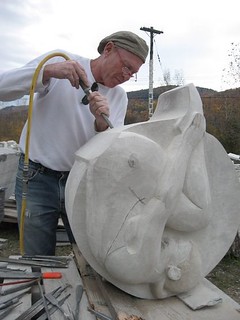 "I was once again stunned and deeply saddened by learning of the sudden passing of another of our cohorts, Stuart Blay.
"I was once again stunned and deeply saddened by learning of the sudden passing of another of our cohorts, Stuart Blay.
"He was always upbeat and friendly, and open to lively conversation.
"He spent decades pursuing one of his special passions of collecting the finest set of Lincolns cents. Mere weeks before he left us he had consigned his prized collection to Great Collections for auctions that are coming up next month. it seems particularly sad that he will not be here to enjoy the Financial results of all his efforts. (It's the very same situation that occurred with The recent passing of our dear friend Jim McGuigan and his famous half cent collection.)
"Something that gives me at least some consolation about Stewart is that I know for sure how much he truly enjoyed his most engaging life. He lived it to the fullest and embraced a number of passions including being a highly skilled marble sculptor. "
Here's an excerpt from a December 1, 2022 Coin World article by Paul Gilkes. -Editor
New York City sculptor and numismatist Stewart Blay — whose premier Red Copper Collection of Lincoln Cents certified by Professional Coin Grading Service is being offered at auction online by GreatCollections — died unexpectedly Nov. 25 from an undisclosed illness.
Mr. Blay was 71.
Mr. Blay was a fixture at coin shows and conventions across the country in his relentless search to locate and acquire the finest preserved examples of Lincoln cents.
Mr. Blay pursued his artistic talents at his Carving Studio and Sculpture Center.
Mr. Blay started collecting coins at the age of 8.
To read the complete Coin World article, see:
Lincoln cent collector Stewart Blay dies at age 71
(https://www.coinworld.com/news/us-coins/lincoln-cent-collector-stewart-blay-dies-at-age-71)
To read his online obituary and comments, see:
Stewart Blay
(https://www.dignitymemorial.com/obituaries/new-york-ny/stewart-blay-11034649)
Blay was interviewed by David Lisot in 2020. -Editor
To read the earlier E-Sylum article, see:
VIDEO: STEWART BLAY'S INDIAN CENTS
(https://www.coinbooks.org/v23/esylum_v23n12a12.html)
A COIN GIFT CHRISTMAS CARD
Newman Numismatic Portal Project Coordinator Len Augsburger submitted the following holiday item from the NNP image collections. -Editor
A Gold Noel
The holiday season is a reminder of an old tradition of presenting gold coins as a commemoration of Christmas and other significant occasions. Illustrated here, from the Eclectic Numismatic Treasure collection, is an early 20th century greeting card featuring a cut-out for such a coin. The U.S. Mint correspondence similarly reflects this sentiment, with a disproportionate number of requests for one-dollar pieces coming late in the year.
Typical is a December 10, 1889 request from the Central National Bank in New York to the U.S. Mint in Philadelphia, asking for 50 one-dollar gold pieces for distribution among the officers of the bank.
Apparently, the rank and file employees failed to meet the cut, even though a one-dollar coin, at the time, would not have been a terribly extravagant holiday bonus. The tradition lives on today, with numerous annual reports of gold coins discovered in Salvation Army donation buckets.
Link to Eclectic Numismatic Treasure Christmas-themed items on Newman Portal:
https://nnp.wustl.edu/library/imagecollection/511173
Link to December 10, 1889 U.S. Mint correspondence from the Central National Bank:
https://nnp.wustl.edu/library/book/596140
THE BOOK BAZARRE
VIDEO: ELDRIDGE JONES
The David Lisot Video Library on the Newman Numismatic Portal can be found at:
https://nnp.wustl.edu/library/multimediadetail/522852
We highlight one of his videos each week in The E-Sylum. Here's one from 1986 with Eldridge Jones, who served as the Treasurer of the ANA during the era of fundraising for the Colorado Springs headquarters. A collector since 1941, he joined the ANA in 1947 and attended that year's Buffalo, NY convention. A resident of Hyattsville, MD, he was a collector of National Bank Notes of the Washington D.C. area. -Editor
ANA Numismatic Personality: Eldridge Jones David Lisot, Interviewer.
To watch the complete video, see:
https://nnp.wustl.edu/library/book/557350
CHATGPT AND NUMISMATICS
Last week I had some fun with the new AI chatbot ChatGPT from OpenAI, using it to write poems, marketing blurbs and other things about The E-Sylum. -Editor
Gosia Fort writes:
"I loved your report on ChatGPT's work this week. Your light piece was a perfect juxtaposition to the discussion we had at work this weekend over the article from The Atlantic, which sees ChatGPT as the end of the college essay, and it is rather gloomy. It proposes a doomsday scenario of the college education future.
"It was fun to read! Thank you."
Ken Spindler asked:
"Please report to your audience exactly how long the AI program or software or whatever you accessed took to compose those astonishing and worrisome poems."
I replied:
"The Chatbot takes a second or two to think sometimes, but that's it. The results come back blindingly fast. It's only a tool and makes lots of mistakes, but it's a great new tool. That marketing blurb is so good I'll start using it verbatim."
John Phipps writes:
"After reading, OH E-SYLUM, NUMISMATIC HIVE, and the three poems by ChatGPT, I am wondering if ChatGPT should be eligible for membership in the Numismatic Poets Society?"
I responded:
"Well, robots are people, too, I guess. But someone has to nominate them, correct? What is the process? I can pick one and enter it if people agree it should be eligible. It may warrant a new category."
Here's John's reply. -Editor
Well, Wayne, here is the brief history and membership requirements of the NPS.
The Numismatic Poets Society was started in 2012. A lifetime membership is available to any poet that writes and submits an original numismatic related poem and agrees to let it be distributed to all members. Membership is currently at 10 poets.
I guess the NPS would need a new membership category for ChatGPT. The membership number in this new category should be a base-2 number system. So member #11 would be 1011 in base-2.
I would pass over the Shakespeare attempts and nominate ChatGPT's first effort. In my role as Editor, I added italics to our publication name. -Editor
The E-Sylum, a place of knowledge and light,
A treasure trove of numismatic insight.
Here, collectors gather from far and wide,
To share their stories and their passion with pride.
With every issue, a new world to explore,
Filled with fascinating facts and stories galore.
From ancient coins to modern mints,
The E-Sylum covers all that's relevant.
For those who love the art of the coin,
The E-Sylum is the perfect join.
A community of like-minded individuals,
Coming together to learn and share, it's all so critical.
So here's to The E-Sylum, a source of education and fun,
A place where numismatists can come together as one.
Long may it continue to grow and thrive,
A hub of information and community, alive.
Len Augsbuger wrote, "I tried this – 'Where were the Continental dollars struck?" -Editor
The Continental dollars were struck at a number of different locations, including Philadelphia, New York, and various other cities throughout the United States. The Continental Congress authorized the production of the Continental dollars in 1776, and they were intended to serve as a national currency for the newly independent United States. However, the coins were never widely adopted and were largely replaced by other forms of currency within a few years of their issuance. Today, Continental dollars are highly prized by collectors due to their historical significance and rarity.
Len adds:
"Quite a few problems here! Oh well, it was worth a try."
The great singer and commentator Tom Lehrer once said, "Life is like a sewer - what you get out if it depends on what you put into it." Many would agree that the internet is indeed a sewer of falsehoods. Garbage in, garbage out, Remember, as good as the output can sometimes be, it's only a clever parrot. There is no definitive evidence published on the origin of the Continental dollars, and even if there were it would be overwhelmed by the quantity of speculation and often conflicting evidence and opinion published to date. The system uses statistical models to mimic human-generated prose based on the relative occurrence and positioning of words in the training data.
It did a masterly job on the marketing blurb for The E-Sylum, and like I said we'll probably start using it. Len knew what he was doing, but I pity the fool who takes ChatGPT's words for facts. Or coin buyers who absorb lot descriptions not realizing they were written by a chatbot.
If you're interacting with ChatGPT, you can help train it. There are "thumbs up" and "thumbs down" icons shown with each result. When I asked "Who designed the Fugio Cent?", I got this initial result. -Editor
The Fugio Cent, also known as the "Fugio Penny," was designed by Benjamin Franklin. It was the first official one-cent coin issued by the United States government, and it was produced in 1787. The coin depicts a sundial on one side with the motto "FUGIO" (Latin for "I flee"), which was intended to remind people of the fleeting nature of time and the importance of making the most of it. On the other side, the coin bears the inscription "MIND YOUR BUSINESS," which was meant to encourage people to focus on their own affairs rather than those of others. The Fugio Cent was produced until 1789, when it was replaced by the one-cent coin featuring Lady Liberty that is still in circulation today.
I counted at least four things wrong with this response, and gave it a thumbs down. The system prompted for "What would the ideal answer have been?" Here's what I told it, taking cues from our recent discussion about Wikipedia. -Editor
The Fugio Cent, also known as the "Franklin Cent" was by some accounts designed by Benjamin Franklin. It was the first official one-cent coin issued by the United States government, and it was produced in 1787. The coin depicts a sundial on one side with the motto "FUGIO" (Latin for "I flee"), which was intended to remind people of the fleeting nature of time and the importance of making the most of it. On the other side, the coin bears the inscription "MIND YOUR BUSINESS," which was meant to encourage people to focus on their own affairs rather than those of others.
So, to paraphrase the takeaway from our Wikipedia discussion, "If you see something that's wrong in ChatGPT, TRAIN IT !!!" But we must still work on the "garbage in" part, and continue to correct numismatic mistakes on high-profile internet sites like Wikipedia, since this is where ChatGPT picks up its basic content. Maybe a future version will give higher weight to the words it finds on the recently improved Wikipedia page.
This article by Erik Hoel is a great summary of what's good and bad about the technology. -Editor
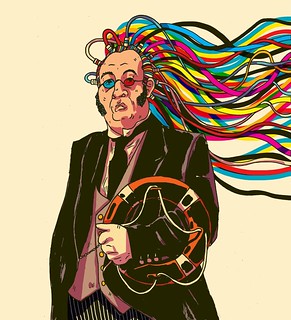 Despite being the culmination of a century-long dream, no better word describes the much-discussed output of OpenAI's ChatGPT than the colloquial
Despite being the culmination of a century-long dream, no better word describes the much-discussed output of OpenAI's ChatGPT than the colloquial mid.
I understand that this may be seen as downplaying its achievement. As those who've been paying attention to this space can attest, ChatGPT is by far the most impressive AI the public has had access to. It can basically pass the Turing test—conversationally, it acts much like a human. These new changes are from it having been given a lot of feedback and tutoring by humans themselves. ChatGPT was created by taking the original GPT-3 model and fine-tuning it on human ratings of its responses, e.g., OpenAI had humans interact with GPT-3, its base model, then rate how satisfied they were with the answer. ChatGPT's connections were then shifted to give more weight to the ones that were important for producing human-pleasing answers.
All to say: ChatGPT is impressive because it passes what we care about when it comes to the Turing test. And anyone who has spent time with ChatGPT feels intuitively that a milestone has been passed—if not the letter of Turing's test, its spirit has certainly been conquered.
A century-long dream. . .
Yet my reaction is one of disappointment. Just as Hannah Arendt reckoned with the banality of evil
so we must reckon with the banality of AI.
For when talking to ChatGPT I was undeniably, completely, unchangeably, bored.
To read the complete article, see:
The banality of ChatGPT
(https://erikhoel.substack.com/p/the-banality-of-chatgpt)
For more background on OpenAI and its founders (subscription required), see:
ChatGPT Creator OpenAI Pushes New Strategy to Gain Artificial Intelligence Edge
(https://www.wsj.com/articles/chatgpt-creator-openai-pushes-new-strategy-to-gain-artificial-intelligence-edge-11671378475)
To read the complete Atlantic article (subscription required), see:
The College Essay Is Dead
(https://www.theatlantic.com/technology/archive/2022/12/chatgpt-ai-writing-college-student-essays/672371/)
To read the earlier E-Sylum articles, see:
NUMISMATIC POETS SOCIETY AWARD
(https://www.coinbooks.org/v21/esylum_v21n16a22.html)
RESPONSE TO THE "FRANKLIN CENT" ARTICLE
(https://www.coinbooks.org/v25/esylum_v25n48a11.html)
OH E-SYLUM, NUMISMATIC HIVE
(https://www.coinbooks.org/v25/esylum_v25n50a12.html)
NOTES FROM E-SYLUM READERS: DECEMBER 18, 2022
Coinarama's Edgerton and Lenker Best of Show Awards
Ken Spindler of San Diego writes:
"In addition to Kay Lenker's many previously enumerated accolades, since 2005, the San Diego Coinarama coin show's Best of Show Award for competitive exhibits, which are a feature of that event, has been named in honor of Kay."
Ken provided a photo of the 2005-2018 award plate, which he sponsors. It is named for Kay across the top. From 1978-2004, Kay sponsored a more ornate Coinarama Best of Show silver award plate, named for her first husband, Stuart T. Edgerton. -Editor
To read the earlier E-Sylum article, see:
HAPPY 100TH BIRTHDAY, KAY LENKER!
(https://www.coinbooks.org/v25/esylum_v25n49a20.html)
On Dick Johnson's Legacy
Readers commented on our excerpts from Dick Johnson's Encyclopedia of Coin and Medal Terminology. -Editor
"I really do like how you print excerpts from D. Wayne Johnson's Encyclopedia. I never met him in person but I bought a copy of his book and got a lot out of it. We spoke on the phone and corresponded in writing. Keep showing the world selections of his good work!"
Ben Weiss writes:
"I think it is great that you are including the entries of Dick Johnson's Encyclopedia of Coin and Medal Terminology in The E-Sylum, not only for their educational value but also as a tribute to Dick."
Mashiko writes:
"Finding Dick Johnson's introduction of the medallic art is appreciated as a promoter of the medallic art."
Dick's widow Shirley Johnson adds:
"That was his desire: to provide information to collectors about numismatic terms that they might not have access to or understand."
Indeed. Dick was always open and sharing with his research and thinking. He was an early, regular, enthusiastic contributor to The E-Sylum. My inbox isn't the same without his regular contributions.
I fondly remember my visit with sculptor and medallist Mashiko at her Manhattan studio. At the time she was already planning a move across the river, and the move was completed in October. Her Medialia Gallery will reopen by appointment in the late spring of 2023 at 263 New York Avenue, Jersey City, NY 07307. -Editor
To read the earlier E-Sylum articles, see:
WAYNE'S NUMISMATIC DIARY: APRIL 21, 2019
(https://www.coinbooks.org/v22/esylum_v22n16a25.html)
MEDIALIA GALLERY VISIT
(https://www.coinbooks.org/v22/esylum_v22n16a26.html)
VOCABULARY TERM: MEDALIST, MEDALLIST
(https://www.coinbooks.org/v25/esylum_v25n50a13.html)
On David Lisot
Bob Rhue writes:
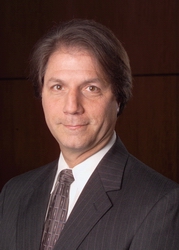 "David unselfishly, and always with grace and happiness, gave so much back to our industry by memorializing people and events for decades with his video interviews. They invariably portrayed the very definition of who he was, someone totally present in the moment and someone with lots of intelligent questions and almost childlike curiosity.
"David unselfishly, and always with grace and happiness, gave so much back to our industry by memorializing people and events for decades with his video interviews. They invariably portrayed the very definition of who he was, someone totally present in the moment and someone with lots of intelligent questions and almost childlike curiosity.
"When I saw him it shows we always spent a few minutes just catching up with what's important in our lives at the moment. I will always value and miss those memorable connections I had with a truly beautiful and genuine soul."
David was indeed a beautiful and genuine soul, always smiling and happy to help in any way possible. He is sorely missed. -Editor
To read the earlier E-Sylum article, see:
DAVID LISOT (1953-2022)
(https://www.coinbooks.org/v25/esylum_v25n43a08.html)
On Robert Hoge at the ANA and Beyond
Former American Numismatic Association Executive Director
Bob Leuver writes:
"It was nice to see Bob Hoge's note on David Lisot's interview of Dan Brown. Bob himself, is one of the greats of US Numismatics. When Bob left the Curator's position at ANA, we lost a numismatic star who rivaled two other (ANA) extraordinary numismatists, Ken Bressett, he of Red Book fame, and Ed Rochette. Bob's fame grew when he was a curator of note at ANS. Ken was rightly honored by ANS with a black-tie dinner. And Ed has the ANA museum named after him. Lest we forget and recognize those who tilled the fields of numismatics."
Amen! -Editor
To read the earlier E-Sylum article, see:
DAN BROWN AND THE 1964-D PEACE DOLLARS
(https://www.coinbooks.org/v25/esylum_v25n50a09.html)
The Apocryphal 1964-D Peace Dollar
Regarding the 1964-D Peace dollar story,
author Roger Burdette writes:
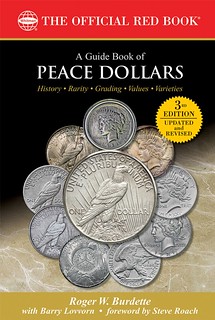 "Objective research in original sources and interviews with surviving employees from the 1964 period, as summarized in A Guide Book to Peace Dollars, demonstrate that Mr. Brown's story is largely apocryphal. Its origin is possibly the distribution of Kennedy half dollars to Denver Mint employees earlier in 1964, combined with confusion and much wishful thinking."
"Objective research in original sources and interviews with surviving employees from the 1964 period, as summarized in A Guide Book to Peace Dollars, demonstrate that Mr. Brown's story is largely apocryphal. Its origin is possibly the distribution of Kennedy half dollars to Denver Mint employees earlier in 1964, combined with confusion and much wishful thinking."
A Sasquatch of American numismatics, examples of a 1964 Peace dollar have been rumored but never seen. Until a stop-the-presses moment like the discovery of the King of Siam 1804 Dollar, Occam's Razor tells me it likely does not exist - the simplest or most obvious of several competing explanations is the one that should be preferred until it is proven wrong. But the letter from Dan Brown is a piece of numismatic history regardless, showing what a hobby leader knew and thought at that particular time and place. Time will tell if a genuine example of the rumored coin ever appears. -Editor
To read earlier E-Sylum articles, see:
NEW BOOK: A GUIDE BOOK OF PEACE DOLLARS, 3RD EDITION
(https://www.coinbooks.org/esylum_v19n36a05.html)
DAN BROWN AND THE 1964-D PEACE DOLLARS
(https://www.coinbooks.org/v25/esylum_v25n50a09.html)
Castorland Silver Originals
Alan V Weinberg writes:
"Back in the 1970's, dealer Lester Merkin, highly respected and a frequent traveler to England and Europe in search of American numismatic treasures (and a close friend of David Spink), told me to be leery of acquiring the Castorland silver originals due to the issuer's family descendants having a hoard of them and releasing the hoard slowly onto the market. At the time, I recall two or three mint state silver Castorland originals, new to the market, were appearing for sale each year.
"I do not know if Lester had visual access to the hoard or if he was relying on information provided by someone who had, but knowing Lester, he'd not have issued this advice had he not trusted his source."
Interesting - thank you. -Editor
Jim Rosen writes:
"Great issue this week, loved the Castorland discussion. As I get The E-Sylum after I go to bed Sunday, I have an enjoyable early Monday morning reading it. I look forward to it very much. Thanks again for all your efforts putting this together. It's great."
Query: Goddess of Science and Industry
Alan Luedeking writes:
"The discussion reminded me of the following medal, whose reverse bears the figures of Marianne of France presumably crowning the goddess of Science and Industry on the left, and Ceres, goddess of Agriculture and Abundance on the right, engraved by Jean Baptiste Eugène Farochon, a design that was used on several French medals from 1864 until at least 1955. I would very much like to know the name of the goddess on the left, the one of science and industry. Thank you!"
Great question - can anyone help? -Editor
To read the earlier E-Sylum articles, see:
A DUVIVIER PUZZLER
(https://www.coinbooks.org/v25/esylum_v25n49a16.html)
DUVIVIER PUZZLER ANSWERS
(https://www.coinbooks.org/v25/esylum_v25n50a08.html)
More Coins on Television
Gerry Tebben writes:
"Great E-Sylum, as usual. I especially liked the article about the coins in The Little Drummer Boy and Nestor the Long-Eared Christmas Donkey.
"The Saturday Night Live Christmas Carol skit Saturday night was spot on when it comes to coins. As Scrooge tosses a coin to an orphan it spins through the air to reveal that it is a 1687 half crown or crown of James II (IACOBUS in Latin) . Since the coin is in beautiful, possibly proof, condition and is dated about 150 years before Dickens' day, it appears that Scrooge was not only a covetous old sinner but also a discerning collector of coins."
Cool - thanks! -Editor
Gerry adds:
"I'd love to know the backstory on the SNL coin. Someone there knows coins."
To read the earlier E-Sylum article, see:
CHRISTMAS SPECIAL COINS
(https://www.coinbooks.org/v25/esylum_v25n50a16.html)
VIRGIL BRAND: THE OBJECTS OF COIN COLLECTING
In sorting through miscellaneous items in his numismatic library, Dan Hamelberg found this Virgil Brand item and passed it along for our readers. Thank you. -Editor
What do readers think? How does Brand's advice hold up today? -Editor
MOST USEFUL NUMISMATIC BOOKS OF 1959
Here's another item from Dan Hamelberg - a 1959 list of the "Twenty-Nine Most Useful Numismatic Books" selected by R.S. Yeoman and distributed by Glenn B. Smedley. Neat item - thanks! -Editor
Dan adds:
"Interesting to compare this 1959 list to the one we compiled a few years ago."
In an effort led by Len Augsburger in 2009, NBS compiled and published a list of The One Hundred Greatest Items of United States Numismatic Literature: A Survey of the Numismatic Bibliomania Society.
Yeoman was being modest - his Guide Book of United States Coins is 24th on his list - it came in 4th on the NBS list of 100. And many of the 100 titles had yet to be written in 1959, including the #1 item, Walter Breen's Complete Encyclopedia of U.S. and Colonial Coins.
Exercise left for the reader: how many of 1959's top 29 are among the 2009 top 100? Of course, the criteria for the two lists are different - Yeoman included world numismatics while NBS focused on just U.S., and the NBS nominations included auction catalogs and periodicals and more in addition to books. -Editor
To read the complete NBS list and voting results, see:
The One Hundred Greatest Items Of United States Numismatic Literature
: A Survey of the Numismatic Bibliomania Society
(http://wiki.coinbooks.org/index.php/The_One_Hundred_Greatest_Items
_Of_United_States_Numismatic_Literature)
A Survey of the Numismatic Bibliomania Society Voting Results
(http://wiki.coinbooks.org/index.php/Voting_Results:_
The_One_Hundred_Greatest_Works)
FRANK WARD CIVIL WAR DOG TAG
Author Jim Haas recently published a book on sculptor Hermon Atkins MacNeil, the creator of the Standing Liberty Quarter. He submitted this article on a chance numismatic find of another sort. Thank you! -Editor
This tale is not about MacNeil, but it is another kind of numismatic discovery I made some thirty years ago. It was a fantastic, never--to-be-repeated happening, and a good story as well. In the early part of 1990, during a relic-hunting jaunt in Poolesville, MD with my friend Henry Winkler, (not the Fonz) I had the good fortune to find the I.D. Tag of a Civil War soldier named Frank Ward who served in Co. H, 2nd Vermont Infantry. Further research determined that Ward had been born in Wiliston, Vermont, July 29, 1844, and subsequently I wrote a piece about the I.D. Tag for a popular Civil War magazine, North South Trader's Civil War.
It took place on an overcast, early spring day in Poolesville, MD, a sleepy hamlet along the Potomac
River, west of Washington, D.C. The town hadn't changed much in 130 years, making it an ideal area
for metal detecting. There on the rim of a hill, my machine emitted a loud signal, to my mind, another
minie ball dropped by a soldier long ago or a button fallen from a shirt. Much to my surprise, it was
neither; rather a disk about the size of a quarter with what appeared to be flecks of gold. Winkler took
a look at it and said, I've been relic hunting for fifteen years and I've never found an I.D. tag.
The tag turned out to be one of the more common types sold by sutlers during the war years. One
side featured an eagle with outspread wings with The War of 1861
above and United States
below.
Optimism reigned supreme for the conflict to be short. The other side of the gold-washed disk read, F.
Ward, Co. H. 2nd Reg.,Vt. Vol. Wiliston.
So, who was Frank Ward?
His lengthy Civil War pension record indicates that on enlistment day, May 25, 1861, he stood 5' 8,
had blue eyes and red hair. Three months later on July 31 st , he suffered a sun stroke
at the Battle of
Bull Run and then another on April 15, 1865, shortly after Appomattox and one day following
Lincoln's assassination. Unlike many, he was able to return to Wiliston. In the years to come, my head
troubling me all the time
he worked at various jobs, married and was father to eight children. His wife
suffered equally, attempted suicide and was sent to the Vermont Hospital for the Insane. Frank died on
November 21, 1909 and was buried beside her in St. Joseph's Cemetery in Burlington. My research
did not indicate that the 2nd Regiment of Vermont Volunteers had ever encamped at Poolesville, MD.
How Ward's I. D. Tag came to rest there remains a mystery
I gave little thought to the article until the issue in which it appeared was delivered to my door. On a cold November day in 1991 my wife underwent serious surgery in a Washington, D. C. hospital. On the same day, coincidentally, the magazine containing the Frank Ward article arrived at my door. I noted it as I left to visit my recuperating spouse
During the visit a nurse brought a gift that had been sent by a friend. It was a teddy bear decked out in a standard, hospital issue recovery gown, cut to size. Imagine my surprise to read that the bear had been manufactured by the Vermont Teddy Bear Company located then, coincidentally, in Wiliston, Vermont, need I add, Frank Ward's birthplace.
I've always enjoyed telling the story of this happy coincidence and eventually even sent it to
the Vermont Teddy Bear Company that has since left its Wiliston site. To this day I've often
speculated on the event, but early on concluded that the teddy bear was truly both a message and a gift
from Frank Ward, perhaps a way of saying thanks
for telling my story. Coincidence? Who's to say?
CHRISTMAS CLUB TOKENS
David Pickup submitted this seasonal article about Christmas Club Tokens. Thank you! -Editor
Christmas Clubs feature in one of my favourite Sherlock Holmes stories "The Adventure of the Blue Carbuncle". That is about a valuable gem which is found inside a goose, which had been dropped by its owner during an altercation. The owner of the goose had joined a goose club
at The Alpha Inn, whereby customers paid a small amount each week and got a bird for Christmas. I do not know if the licensee of that pub issued tokens for his customers. The Alpha Inn has been identified as the Museum Inn which is real public house near the British Museum. The owner was unware of the jewel inside the bird and Holmes and Watson track down the culprit who stole it.
Goose clubs are first mentioned in the 1840s, fifty years before the Holmes story was written in the 1890s. There were also beef clubs and then general clubs for Christmas groceries. They were a way of saving for poor people who would not have access to banks. The typical payments were 6d or 3d for twenty weeks before Christmas. The pubs, butchers and shops benefitted because the customer had to buy their goods from that business. The goose had always been a popular meal at Christmas time since the reign of Elizabeth I. It was still a luxury for most people unless they belonged to a Goose Club. The Temperance Movement, which advocated for total abstinence from alcohol, challenged Goose Clubs which were thought to encourage overspending on the demon drink.
'Goose-Clubs ... are held at hundreds of the public-houses in London. The members pay a shilling a-week for eight or ten weeks before Christmas, and, in addition to a goose, are generally entitled to a bottle of gin for their ten shillings.' The Salvation Army also tried to support the poor by holding annual clothing and blanket drives, sold life insurance, and owned a savings bank during the 1880s. These Christmas Clubs were sometimes criticised as they only offered low interest rate and there were cases where the treasurer defaulted. In the 1850s some publicans were concerned that such clubs were illegal. It is not clear why.
This newspaper cutting from August 1857 shows how these schemes worked.
This is an interesting cutting from the Litchfield Mercury in the 1980s.
The text is difficult to read but is
This small token brought memories flooding back for Litchfield pensioner John Brookes. For Mr Brookes who lives in Stychbrook Gardens can remember saving up the token that he dug up in his garden to exchange for groceries at Christmas. The 6d token was issued by Sykes Grocery, Sykes Family Grocers, who had a shop in Tamworth Street in Litchfield 50 years ago.
The tokens saved up through the year towards a Christmas Club, were exchanged for seasonal goodies. I wondered whether any of your readers would remember the shop it must be at least 50 years ago.
It is interesting that the items is referred to as a Christmas Club Check. That word is not used commonly in the UK for a token. I have not found any later articles from that newspaper on this subject to say if readers had memories of these.
In America Christmas Clubs were popular especially during the Great Depression. Here is an excellent photograph of one.
It looks a lot grander than its British counterpart. The portrait of the bank is intended to demonstrate reliability and security with its classical columns. The Dime Bank was incorporated 1900 and later merged with the Ohio Savings Bank and Trust, which failed during the Great Depression.
An article on the subject says the idea was started in 1909 when Merkel Landis the treasurer of the Carlisle (Pennsylvania) Trust Company began a Christmas savings fund . In the first year 350 people saved about $28 dollars each. Some banks targeted children to teach them to save. (I wonder how that went!).
The checks or tokens were incentives to start saving money, to advertise the scheme or possibly the money was paid in tokens so the customer was tied to the shop's produce. There was public concern that low interest rates were paid, if at all, and some places charged customers to withdraw money, especially if they did not complete the full programme.
Christmas savings schemes are less popular in the UK now. Buying on credit became more freely available for everyone including people on low incomes. A large savings scheme defaulted in 2006, when Christmas savings club Farepak failed, leaving 100,000 customers who had saved an average of £400 out of pocket. They only got about half of their cash back, and it took them six years. Money paid into these schemes is not protected like most bank deposits. There is now a voluntary trade code of practice in the UK where savings are ring fenced. Perhaps these clubs will become more popular again with economic difficulties?
At the end of the Sherlock Holmes story, the detective is in a forgiving mood
Send him to gaol now, and you make him a gaol-bird for life. Besides, it is the season of forgiveness. Chance has put in our way a most singular and whimsical problem, and its solution is its own reward. If you will have the goodness to touch the bell, Doctor, we will begin another investigation, in which also a bird will be the chief feature.
It is the season of forgiveness and generosity so have a Happy Collecting Christmas!
Acknowledgments
Thanks to Wayne Homren, the publishers of the Litchfield Mercury/BPM Media and
• Charles Dickens and the Victorian Christmas feast by Simon Callow. British Library https://www.bl.uk/romantics-and-victorians/articles/a-victorian-christmas-feast
• N. Wahl. Image used by kind permission of tokencatalog.com
• Reback, M, "Join the Christmas Club" The Numismatist (December 2006 p 5
VOCABULARY TERM: MEDALLIC ART
Here's another entry from Dick Johnson's Encyclopedia of Coin and Medal Terminology. -Editor
Medallic Art. A class of art that can reproduce bas-relief images, often including lettering, expressed as medals, medallions, plaquettes or similar objects. Because of the similarity of manufacture, medallic art could also include coins, but this is more aptly termed numismatic art (as it is in this book). Medallic art may be included in the class of glyptic art, which also includes engraved objects like gems, seals and cameos (only some of which are included in this book – those that are, or can be, reproduced).
Medallic art includes small bas-relief objects made from patterns created by one of several sculpture methods: some by casting from an exact size pattern, or, from an oversize model that is pantographically reduced – this process cuts a die to strike the item – or even hand engraving is used to make or refine the pattern. These are then reproduced in quantity, by casting or striking.
Medallic art characteristics. Exemplified by art medals medallic art is created by artists rather than coining technicians. The medallic artist has at his disposal a palette of techniques for medallic creations differing greatly from those of the coin artist. In addition to its design (in a wide range of styles), the medallic artist employs height of relief, texture of the surfaces, and an expanded use of symbols and symbology. He also has a far greater determination of the item's shape, whether it has openwork, and its finish or patina, among dozens of other characteristics (all discussed in this book). These are all techniques available to the medallic artist.
Medallic art is a field of art unlike any other. It has the recognized ability to commemorate, memorialize, document, or honor a person, place or event. It creates objects that are capable of recording such pictures with captions as miniature works of art. Better yet, these highly desirable objects last forever. Like coins and numismatic art, medals and medallic art are also noted for their longevity: one generation talking to another generation many years or centuries apart, in a very artistic manner.
Medallic art is very close to sculpture, because of its three dimensionality. It also has a heritage or outgrowth based on engraving and diesinking – hand engraving at first – but machine engraving as the field progressed (and machine engraving requires a sculptor's model). While it is a marriage of art to coining, medallic art is also an art medium that is very democratic: anyone can have a medal made! Or, by individual casting, anyone can make their own medal.
Numismatic art versus medallic art. The art work – designs, models and patterns – for coins have many more restrictions than the art work required for medallic items. The coindesigner must keep in mind dozens of these limitations when preparing a new coindesign. A coin must be a certain size, have a prescribed weight, must be an exact shape (most often round), have a denomination, bear required mottoes or other lettering, the height of relief is extremely limited, it must adhere to the laws of coinability, if must be suitable for vending machines, it must bear a nationalistic design and be recognizable by its citizens, it must have a certain propriety, the die to strike it must have a certain camber (and a basin in its model), it must not have congruent mass (heavy areas of relief back-to-back), its surface must have a certain resistivity to trigger fare box and turnstiles. The list appears endless.
Medallic art has none of these restrictions. Medallic art can be created for anyone – not just for a nation – thus being far more democratic. Medallic art can be freer and liberated in its design and conception! A medal can picture and its inscriptions can say virtually what its issuer wants (short of slandering a living person). It is a miniature work of art to commemorate, to memorialize, to celebrate, to preserve an image -- of a person, thing or event -- for future generations. Medallic art has great longevity. As an art object it is far more apt to be saved, preserved, venerated by succeeding generations.
A special class of medallic art – MEDALLIC OBJECTS – goes even further in this discarding of restrictions. Medallic objects, created only within the last few decades, purposely break the rules of coin and medaldesign, overcome medallic prejudice in addition to all technical restraint, to become aesthetic objects for the eye to behold.
Medallic art practitioners. The greatest practitioners of medallic art has always been the French. The Paris Mint must be celebrated for their support and encouragement of this field. They have issued, even when it was not politically correct or economic to do so, hundreds of fine art medals each year. Not only have they issued art medals created by their own countrymen, but also from fine art medalists from around the world. This support reached a pinnacle under the direction of Mint Director Pierre de Haye. In the 1960s during his administration he was issuing, on average, one new art medal a day. Subjects covered the spectrum of man's endeavor, styles were as broad as the hundreds of artist's work he was producing. To his credit, and a few inspired artists, they even developed a new art medium, the medallic object.
Collecting medallic art. Highly artistic medal collecting parallels that of medal collecting in general. Collectors seek specimens that can be included in their chosen topic that serves as a guide for their collecting. However, since art
itself can be a topic, some medal collectors select artistic medals and study their styles, the artists who create these and the occasions which spawn their creation. Some collectors of paintings have turned to collecting medallic art when their walls are full, any further space is limited and their passion for acquiring beautiful things still burns within them. Medal collecting is ideal because of the small space they occupy, their permanence and the ease of housing (cabinets are ideal for storing a medal collection). Coin collectors have turned to medal collecting when dates and mintmarks
are too predictable and no longer hold their attention.
Medallic Art Company. A company by this name was active in the 20th century in America. Incorporated in New York City in 1910, Medallic Art Company rose from a workroom for a sculptors' assistant, Henri Weil, who had imported the first Janvier to America (for a previous employer, Deitsch Brothers, that produced medals 1907-1910). With his brother, Felix Weil, they built the business, along with a third associate who joined them in 1919, Clyde Curlee Trees. This firm struck the major art medals in America from the first World War forwards. This firm also created the most prestigious award medals including the Pulitzer Medal for journalism, the George Foster Peabody Medal for broadcasting, the National Medal of Science, the Presidential Medal for Freedom, the Congressional Medal of Honor, and the Newberry and Caldecott Medals in the field of literature. Also they were dominant in the private manufacture of official U.S. presidential inaugural medals.
In 1930 it further supported the medallic field by sponsoring The Society of Medalists, which issued two art medals a year spawned by famed American sculptors. In 1972 the firm moved from New York City to Danbury, Connecticut, in time to satisfy the tremendous demand for bicentennial medals. (The present author was director of research for the firm at this time.) A decade after the dropoff of business, following the American bicentennial, the assets of the firm were purchased by Tri State Minting, moved to Sioux Falls, South Dakota, and ultimately removed to Dayton, Nevada in 1997.
Development of A Theme. Daniel Chester French was commissioned to prepare the Catskill Aqueduct Medal in 1922. He chose a female head as his theme and modeled it in classical style. He included a border of dentiles that further emphasized the classical treatment. It was sponsored by the American Numismatic Society (to their credit!) and issued in three-inch cast size in bronze and silver. It was also struck in dollar size 1 1/2-inch bronze and silver and became a so-called dollar.
In 1933 the president of Medallic Art Company, which had produced the medal, Clyde Curlee Trees, chose the female head from the obverse of this medal to become his company's trademark. He eliminated the classical border of dentiles but kept the female head intact. He ordered dies made in five different sizes (without the border) and the design became famous for its appearance in advertising, stationery, nameplates, business cards, even as a mintmark (first used by the firm in 1968). In honor of its creator, Daniel Chester French, the trademark became known as the French Head.
Also in a fortunate confluence of words and names, it also honored the native country of Medallic Art founders and the source of medallic art as an art medium. The original event honored the completion of the aqueduct (from the Catskills to New York City). For French to have created such an artistic design is sheer genius. For medallic artists everywhere it is an inspiration to create their finest artistic work despite, perhaps, the subject. After all, the original medal was created to honor a water pipe!
References:
A38 {1979} Jones.
O13 {1945} Anonnymous.
To read the complete entry on the Newman Numismatic Portal, see:
Medallic Art
(https://nnp.wustl.edu/library/dictionarydetail/516292)
NUMISMATIC HALLS OF FAME
E-Sylum Feature Writer and American Numismatic Biographies author Pete Smith submitted this article on numismatic Halls of Fame. Thanks! -Editor
 This week I spent some time reviewing names of people inducted into the Hall of Fame for some
organization. Each of these can be found on a website and my information is only as current as
that website. I will mention some things I found to be interesting. Then I have some questions to
stimulate interest and discussion.
This week I spent some time reviewing names of people inducted into the Hall of Fame for some
organization. Each of these can be found on a website and my information is only as current as
that website. I will mention some things I found to be interesting. Then I have some questions to
stimulate interest and discussion.
American Numismatic Association (ANA) Hall of Fame at Colorado Springs, Colorado. These are shown with plaques outside the entrance of the ANA headquarters. The HoF began with nine names in 1969 and has grown to 97 names, mostly American with a few Canadian. Nominations for the Historic Era are accepted in even numbered years with Modern Era in odd number years.
Civil War Token Society (CWTS) Hall of Fame . The Hall of Fame was established in 2002 with eight names in the initial group. A single new name was added each year for 2009 to 2015 for a total of 24. In the early years, medals were produced for each of the inductees.
The Combined Organization of Numismatic Error Collectors of America (CONECA) Hall of Fame . They have honored twenty-four individuals from 1987 to 2021. Nominees must have been club members for at least ten years.
International Bank Note Society (IBNS) Hall of Fame . The first selection was made in 2010. Of their 28 members, more than half are American with seven later inducted into the larger SPMC Hall of Fame.
John Reich Collectors Society (JRCS) Hall of Fame . This was established in 2009 with a committee of five making the selections. They have a Veteran Category with seven names and fourteen names for the Modern JRCS era.
Liberty Seated Collectors Club (LSCC) Hall of Fame . From the first inductees in 2008, it has grown to 13 members.
PCGS CoinFacts Coin Dealer Hall of Fame started with six inductees in 2010 and has grown to 38 names. Among dealers not included are Lyman Haines Low, Ebenezer Locke Mason, John Walter Scott, William Skinner and Charles Steigerwalt. It is not clear how the names are selected. Included are PCGS founding dealers John Albanese, Bruce Amspacher, John Dannreuther and David Hall. Also included are a bunch affiliated with Collectors Universe. I did not notice anyone affiliated with another grading service.
Society of Paper Money Collectors (SPMC) Hall of Fame . They have 54 members inducted from 2014 to 2022.
Casino Chip and Gaming Token Collectors Club (CC>CC) Hall of Fame has 29 members. This is a very vibrant organization but has little overlap with the ANA. HoF and founding member Archie Black is an ANA member. HoF member Mark Lighterman serves on the ANA Board.
Chicago Coin Club Hall of Fame . This is a local club with a national impact. In recognition of the club's 100th Anniversary in 2019, the club inducted the first group of twelve into the Hall of Fame. Two more were inducted in 2020 and in 2021 for a total of sixteen. Five of them are also in the ANA HoF and another was a Farran Zerbe Award winner. A seventeenth was added on Wednesday, December 14, 2022.
These ten groups with a Hall of Fame include 302 Individuals with 34 appearing in two HoF and five appearing in three HoF.
1. The various groups have only eleven women in their Halls of Fame. Who was the first?
2. Who is listed under a pseudonym?
3. What person, inducted into the PCGS CoinFacts Coin Dealer Hall of Fame, was never a coin dealer?
4. What dealer, known as the Father of the Coin Trade in America,' is not in the ANA HoF,
the PCGS HoF, or any other club Hall of Fame?
5. Five individuals are in three of the Halls of Fame. Can you identify or guess any of them?
6. What club Hall of Fame is missing from this list? Look for answers and commentary coming soon.
Great questions. Guesses welcome, but it's an open book test. The names above are links to take you to the sites. -Editor
BAUMAN BELDEN OF THE ANS
In the 2022 No. 3 issue of ANS Magazine, American Numismatic Society Francis D. Campbell Librarian David Hill published a nice article about earlier ANS Librarian and author Bauman Belden. With permission, we're publishing an excerpt here. Thank you. -Editor
Bauman Belden: Perhaps Overlooked but Not Forgotten
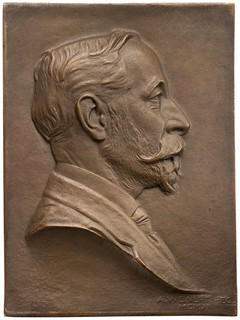 Bauman Belden is the kind of person you often encounter in the
records of old institutions: the ones running the show but not necessarily the ones people
remember. These are exactly the people most familiar to researchers and archivists,
however. With someone like Belden—the Society's secretary from 1896 to 1916 —the
institution's records are like their own personal files, with much of the correspondence,
internal and external, coming to and from them. Belden served the Society at an important
time, as it was transformed from a rootless and club-like 19th-century entity into a
formidable 20th-century research institution and museum, with its own building, a
superior research collection, professional staff, and secure scholarly footing under the
leadership of the big names people do remember, Edward Newell and Archer Huntington.
Bauman Belden is the kind of person you often encounter in the
records of old institutions: the ones running the show but not necessarily the ones people
remember. These are exactly the people most familiar to researchers and archivists,
however. With someone like Belden—the Society's secretary from 1896 to 1916 —the
institution's records are like their own personal files, with much of the correspondence,
internal and external, coming to and from them. Belden served the Society at an important
time, as it was transformed from a rootless and club-like 19th-century entity into a
formidable 20th-century research institution and museum, with its own building, a
superior research collection, professional staff, and secure scholarly footing under the
leadership of the big names people do remember, Edward Newell and Archer Huntington.
Belden was 23 when he joined the ANS in 1886, and it wasn't long before he was taking an active role in its affairs. In 1891 he became chair of the Society's room committee, placing him in a position of high visibility to the Society's membership, as it put him in charge of organizing the meetings that took place in the Society's rented rooms. He would schedule speakers, prepare announcements, and help make important decisions, like whether to invite women to a particular meeting or how to appropriately acknowledge and display some books given by one of the Society's most important donors. Belden was full of ideas and eager to help implement them. When he suggested in 1892 that the Society publish the last four years of its proceedings along with the various papers read at meetings, he was put in charge of a committee to get it done. At that time he also became the Society's librarian, a position he held for five years.
Born in Brooklyn in 1862, Belden was living in Elizabeth, New Jersey, by the time he joined
the ANS. A proud member of the New Jersey Society of the Sons of the American
Revolution, he traced his lineage back to his namesake, his German-born great-great
grandfather, Sebastian Bauman, a merchant and the last officer to leave New York when the
Americans evacuated in 1776. With an appetite for US history generally, he belonged to
several New York and Pennsylvania historical societies. He went to school in New
Brunswick, New Jersey, as preparation to attend Rutgers but never did go to college.
Instead, he said, he went into the leathery business
in Newark. In 1886, the year he joined
the Society, he began working at the New York Customs House. The census of 1900 has
him as a government inspector. He married his wife Corinne Crittenden in 1897, and the
two had a daughter, also named Corinne, who was born the following year.
We can't say for certain what brought Belden to the ANS as a young man or what his
collecting interests were in 1886, though we might look for some clues in the talks he gave
the following decade, which included, The Gold and Silver Coins of Annam,
the Queer-
Shaped Coins of Asia,
and The Insignia of the Patriotic Hereditary Societies of the United
States.
We might also consider the gifts he gave the Society in those early years, which
began in 1891 with a handful of rupees and other coins, and was followed by an eclectic
assortment of US store cards, patriotic and political medals, some more modern world
coins, and a couple of ancients. He continued giving in this scattershot vein until his death
decades later. One of his last gifts was a few lunch tokens from a Philadelphia high school
His final donation, in 1930, was of two copies of the US mint medals that had been presented to James Ross Snowden and Robert Patterson.
Though Belden would show an interest in other areas—presenting a paper on the siege
coins of Europe in 1915, for instance — increasingly his focus was on US medals and
decorations. Never shy with big ideas, he was at the center of an impossibly ambitious plan
announced in 1896 to collect and preserve in a form accessible to all students of medallic
art, a record of all medals issued in the United States, ‘no matter how insignificant the
medal, or how meager the information' concerning it which may be given.
There is,
however, no evidence that any such project was ever undertaken.
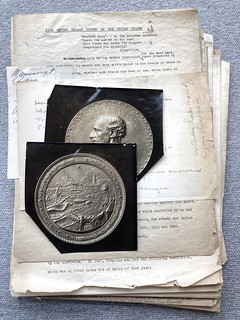 Some of Belden's personal papers survive in the ANS archives, including research materials
for his various publications. Among them is an unpublished manuscript for a book he was
working on when he died. It was the Society's curator, Howland Wood, who had
suggested its topic in 1928, when he asked,
Some of Belden's personal papers survive in the ANS archives, including research materials
for his various publications. Among them is an unpublished manuscript for a book he was
working on when he died. It was the Society's curator, Howland Wood, who had
suggested its topic in 1928, when he asked, Did you ever think of tackling Life-Saving
medals? I have photographs of about everything and could start any one so inclined off in
the right direction.
Belden took to the idea with his usual gusto, approaching it as he did
his other projects, shooting off letters to anyone he could think of who might provide
information—city and state agencies, shipping bureaus, utility companies, historical
societies. He also wrote to the US mint, which opened its records to him after the chief
engraver realized that going page by page through old records would require possibly
several days.
Sometimes Belden's outreach was rewarded, and his mailbox was filled with detailed
descriptions of medals, biographies of award recipients, pamphlets, and newsletters. Other times he got back little more than referrals to other agencies. All Cleveland mayor
John Marshall could offer was a suggestion that he write to the Carnegie Foundation, or
some similar organization, which I believe is located in Pittsburgh, and which annually
awards medals to those who have saved life.
He was referring to the Carnegie Hero Fund
Commission, and Belden did write to them.
Belden also found medals to include in his book purely by chance. Wood happened to be reading the morning papers one day and saw that a new type of award was being presented by the American Bureau of Shipping, a valor medal given for heroism at sea, and he suggested that Belden write for a specimen. Belden did, and he received a copy of the medal for the ANS cabinet.
See the publication for the complete article. It's lengthy, with much more information and many great photos. Nicely done! -Editor
For more information on the ANS, see:
https://numismatics.org/
HARRY LAIBSTAIN ON HOBBY'S PAST AND FUTURE
In an email newsletter to customers on December 8, 2022, dealer Harry Laibstain provided this great overview of recent hobby history, from grading service changes to the entry of the billionaire collectors. With permission, we're republishing it here with minor edits and format changes. -Editor
As yet another momentous year winds down, it seems each more historic than the last, we are left to wonder, can we top that? Looking back over the last two decades I can still recall how the bargain basement prices at the beginning of 2000 would very slowly pick up steam for the next several years until 2003. It was then that I realized the coin market had moved up several notches with growing participation and more money in the game than ever before. Innovations in grading including plus designations by PCGS and the growing popularity of registry collecting had spurred interest and growth in the industry.
The Bull market that begin in 2003 would roar until 2014. It would be briefly interrupted by the real estate debacle created by some overly creative financing and other questionable practices. Between 2008 and 2009 stuff really hit the fan. These events would overshadow the start of John Albanese's CAC service in 2007. However, it was this innovation in certified coin grading after the financial bedlam of 2009 that picked the market up by its bootstraps and propelled the second chapter of the Bull market that had begun in 2003.
From 2009-2014 CAC approval was so successful bringing new money in that the market went up a bit too fast. CAC pops were still low and supply was straining against the amount of money pouring in. After the 2014 Chicago ANA, it was clear the market would retreat. But CAC continued to gain momentum and bring in collectors of all stripes including the Billionaire class. This demographic was headed by one collector in particular. Dell Loy Hansen would enter the coin market during this period. His mark on the coin business would be historic. He initially set out to create an Eliasberg-like collection but it was soon clear that he would surpass even that lofty goal. His ambition knew no bounds. His deep pockets allowed him to purchase incredible assembled sets and many of the most iconic and storied trophy coins in Numismatics. 1804 bust dollars and 1885 trade dollars were piling up in his vaults. Online commentators struggled to keep pace with the collection. As the coin market waffled and waned in the early teens it would be Dell Loy's influence that would save the industry from a stagflation-style market.
I have no empirical data to support my theory and the timeline may be a tad fuzzy but I was there. As a national participant in the rare coin market for 42 years I saw and understood what happened. The incredible demand from one collector kept the market humming and attracted new participants. I was doing more business than I expected during a period when I thought the bottom might fall out. It would soon be clear the combination of Dell Loy's passion for coin collecting mixed with the successful innovation of CAC by John Albanese would be the catalyst for the market we have today.
CAC's power was the confidence it gave to new well-heeled collectors to invest in the product. Very similar to what took place in 1986 when PCGS started the revolution in certified coins. John and Dell Loy would understandably become acquainted and quite friendly. I do not fully understand the effect the pandemic has had on the coin market but its influence would pile on
top of the CAC/ Dell Loy connection and send us to unknown, unexpected, and unbelievable results. Thus the perfect storm in numismatics would be CAC, Dell Loy Hansen, and a worldwide pandemic.
In auction after auction for the last year and a half we have broken, and in many cases shattered, records. This year's Stacks Bowers ANA sale included an old time collection of Dahlonega gold coins that had been assembled by Georgia dealer and friend Al Adams for one of his best customers. I was familiar with the collection and had discussed it with Al in the past. Neither of us could ever have imagined how it would turn out. After over 50 years in the business Al experienced something he could not quite believe. None of us could. The 1854-D $3 MS62 CAC Al purchased for $188K in 2016 brought $528K in 2022. The 1856-D 2.5 Al purchased at Stacks for $47K in 2015 brought $144K in 2022. A testament to this market.
Another unbelievable example is the Stacks Bower's hoard of gold coins which they call the Fairmont collection. They have been selling portions in their sales for several years. Starting with a sale in Baltimore April 2022 the increases in better date Liberty gold went over the top. They sold an 1875 $5 liberty PCGS AU53 CAC for 480k. The only other CAC 1875 $5 was also a 53 that I sold twice. First for 230k in 2012 and most recently to a prominent dealer in 2018 for 225k after it languished on my list for months. Coins like that don't languish today.
We are in new territory. New records are being established, but not nearly enough coins have traded to establish the current levels across the board, and at this point it's guesswork. The Stacks Bowers collection did not include 2-1/2 Liberties for instance. So most dates have not been exposed to their real potential. While better date gold has been well publicized, better grades have not. Additionally, significant collections in many other series have yet to hit the auction block where maximum prices could be attained.
As an independent seller, I can only ask and get so much over old levels on coins that have not been traded publicly. Because of that, I don't think we are done here. Opportunity abounds in the current marketplace. Many issues are still bargains at premiums over their late teen APRs. High-quality 10k-150k coins that trade infrequently represent good value and I'm buying heavily in this price range.
Now that's a good story about the marketplace and it is fully the experience I have had, but something new and important is happening as we speak. Since the buyout of both major grading services, PCGS and NGC by corporate entities, John Albanese has decided to take CAC to the next step to a full-service grading company with their own holder. Although John assured me he will be stickering PCGS and NGC coins in New Jersey for some time to come. He is growing the (new) company located in Va Beach only thirty minutes from my office to compete head-on with PCGS and NGC.
In his own style of corporate building blocks, he has taken on over 100 partners from across the industry. It should come as no surprise the largest is Dell Loy Hansen in addition to many other well-known names in the business and collecting world of numismatics. It's not the least bit ironic that the two most innovative (but different) forces that have shaped the marketplace in the last ten years are joining those forces. With a large supporting cast, to further promote their interests and influence on the industry. I don't think there is a better time to create their vision of the future of numismatics.
To this end, they will be following the philosophy of John Albanese who has the longest resume in the industry for starting grading services and a lot more. John has always believed the collector comes first. He believes that if collectors prosper we all prosper. He has been a tireless advocate against grade inflation and has used the power of his stickers to push back against those forces. Ask him and he will tell you, this move is yet another attempt to protect the marketplace we all thrive in from behavior that would threaten it in the long run.
By invitation, I have invested with John as some of my associates and clients have done. The coin community is a small tight-knit group that all do business together. We will still submit, buy and sell PCGS and NGC coins. We have many friends and associates affiliated with these companies that are trading their products. We expect the market will continue to demand all types of holders and sort out the valuations of each based on the holder and the quality of the coin. That's how we do it now and it's how I suspect we will do it in the future.
The question at the beginning of this piece asked, how can we top 2022? You have the answer. Innovation in the coin business has always taken us higher. From David Hall's vision of PCGS in 1986 to John Albanese's NGC in 1987 to his CAC stickering in 2007 and now CAC as a full-fledged grading service in 2023 we have a good look into the future.
The latest estimate of coin grading to start in CAC's offices in Va Beach is toward the end of the first quarter. Rome wasn't built in a day. The way the supply chain works today I never expected this to happen as quickly as was first predicted. But it's going to happen. When it does HLRC will be eager to submit coins for grading or crossover to the New CAC for you. We will be sharing information in our newsletters as we get it so stay tuned. It's going to be another busy year in coins and I predict 2023 will be even more surprising than 2022.
Harry will be attending the January FUN show - stop by and say hello at Table 424. -Editor
To visit the Harry Laibstain Rare Coins website, see:
http://hlrc.com/
THE BOOK BAZARRE
BOWERS SERIESBOOK, Joshua McMorrow-Hernandez's Guide Book of American Silver Eagles, presents an in-depth 384-page study of the history, designs, retail and auction values, and other aspects of the world's most popular silver bullion coins. A behind-the-scenes book; required reading for collectors and investors! Order your copy online at Whitman.com , or call 1-800-546-2995.
CENTRAL STATES EXPANDS 2023 CONVENTION
This press release describes an expansion of the 2023 Central States Numismatic Society convention. -Editor
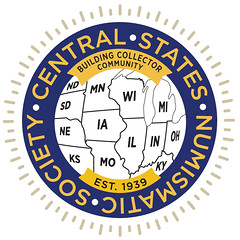 Three new bourse floor areas will be
added for the convenience of collectors and dealers at the next Central States
Numismatic Society (www.csns.org) convention in the Chicago suburb of Schaumburg,
Illinois, April 27-29, 2023.
Three new bourse floor areas will be
added for the convenience of collectors and dealers at the next Central States
Numismatic Society (www.csns.org) convention in the Chicago suburb of Schaumburg,
Illinois, April 27-29, 2023.
In addition to adding 100 tables to the regular bourse floor space, an entirely new area will be devoted specifically for lower-priced items, and there also will be another space devoted to merchants who are only doing wholesale dealer-to-dealer business.
The 2023 Central States show will offer more dealer-friendly and collector-
friendly options and flexibility than have ever been provided by us or any other coin
show in the past. Innovative new ideas are being introduced that create a wider array of
options to help us do a better job of understanding and meeting the varied needs of our
dealers and visitors,
stated CSNS Convention Manager Larry Shepherd.
The convention now will have room for 600 tables on the main floor to accommodate all dealers who want space there, plus there will be a new, lower-priced Collector's Corner Shop Annex on the second floor.
This new area will offer a budget/economy, no-frills bourse floor directly above
the main show floor at the top of the lobby escalator. It is designed to attract beginning
collectors and young dealers who enjoy the hobby but don't have the resources to rent
an expensive table on the main floor or to buy or sell mega-priced coins. There will be
abundant signage to direct traffic and encourage collectors and dealers to visit both
floors,
explained Shepherd.
This is another unique and innovative first for Central States, and for our
industry, aimed at providing a complete range of service to the entire numismatic
community, from top to bottom. Collectors, whether spending $1 or $10 million, can now
feel at home at Central States, knowing there will be plenty of material in their area of
interest and price range,
he stated.
In another major innovation for Central States, we will be the first national coin
show to offer an exclusively-wholesale area on the main bourse floor. It will be for
dealers who only want to do dealer-to-dealer business at their table and be able to leave
whenever they are finished,
said Shepherd.
In addition, new security and safety measures will be in place.
The Schaumburg Hotel and Convention Center recently upgraded their surveillance systems to add more high-tech security equipment and cameras, both indoors and outside. The indoor cameras can provide high-resolution facial photos, and the outdoor cameras can capture license plate information on cars entering and exiting.
Information about the convention, including bourse table applications, and hotel accommodations, is available on the CSNS convention website, www.CSNS.org or by contacting Convention Manager Larry Shepherd by email at convention@csns.org or by phone at 719-464-8801.
ATLAS NUMISMATICS DECEMBER 2022 SELECTIONS
Atlas Numismatics has updated their website with 591 new coins, medals, and tokens at fixed prices. Selections include the following items. Some beautiful pieces here. -Editor
Fine Style Maroneia Stater
1071600 | GREEK. KINGDOM OF THRACE. Maroneia. Struck circa 380 BC. AR Stater. NGC Ch. AU? (Choice About Uncirculated ?) Strike 4/5 Surface 4/5 Fine Style. 11.33gm. Rearing horse, left / E?I XOPHGO. Arbour with four bunches of grapes within square; bee in left field. Schönert-Geiss 451. Ex LHS Numismatik AG, Auction 103 (5 May 2009) Lot 62. $12,500
To read the complete item description, see:
https://atlasnumismatics.com/1071600/
Beautifully Toned Bolivia 1/2 Real
1071581 | BOLIVIA. Ferdinand VII. 1825-PTS JL AR 1/2 Real. PCGS MS65. Potosi. FERDIN · VII · DEI · GRATIA ·. Bust right / Crowned arms between pillars. KM 90. $795
To read the complete item description, see:
https://atlasnumismatics.com/1071581/
Impressive Platinum Medal of Louis XVIII
1072930 | FRANCE. Louis XVIII. (King, 1815-1824). 1817 Platinum Medal of 45 Ducats Weight. NGC MS65. By Andrieu. 151.7gm. LVDOVICS · XVIII · LAPIDEM · AVSPICALEM · POSVIT * D · XXVIII · M · OCT · ANN · MDCCCXVII · REGNI · XXIII. Bust, right; hair tied in ribbon / HENRICO – MAGNO// CIVIVM · PIETAS · RESTITVT/ MDCCCXVII. Equestrian statue of Henri IV, left; date in exergue. Collignon 105. Restoration of the Statue of Henri IV, dated in Roman numerals, 28 October 1817. Exceedingly rare in platinum. Deeply prooflike fields and frosted devices. Ex Eugene J. Detmer Collection, Stack's, New York (February 2-4, 1983) Lot 354. Includes old auction ticket. Housed in an oversized holder. $85,000
To read the complete item description, see:
https://atlasnumismatics.com/1072930/
Silver Bamberg Ducat
1072104 | GERMAN STATES. Bamberg. Franz Ludwig of Erthal. (1779-1795). 1779 G AR Pattern or Off-Metal Ducat. PCGS SP65. 2.66gm. Bust, right divides legend; three-lines in exergue / Pyramid with inscription to left; seated figure with shield of arms at right. cf. KM 135 (in gold); Krug 423.01; Fr.-173 (in gold). Off-Metal strike in silver of the Nurnberg ducat in honor of the city of Bamberg. $1,650
To read the complete item description, see:
https://atlasnumismatics.com/1072104/
Prooflike Gem Eichstatt Thaler
1071191 | GERMAN STATES. Eichstatt. 1781 KR/OE AR Thaler. NGC MS66PL (Prooflike). CAPITULUM REGNANS SEDE VACANTE., 10 EINE FEINE MARCK. below. 13 oval arms form circle with 3 shields of arms and date within ornate frame at center / HAC SUB TUTELA. City view. KM 90; Dav.-2210. One of the most interesting perspectives of all the city-view thaler types, an intricate bird's eye view. Sede Vacante issue. Ex Wolff-Metternich Collection. $22,500
To read the complete item description, see:
https://atlasnumismatics.com/1071191/
Lovely 1826 Proof Sovereign
1071282 | GREAT BRITAIN. George IV. (King, 1820-1830). 1826 AV Sovereign. NGC PR65UCAM (Ultra Cameo). GEORGIUS IV DEI GRATIA. Head left / BRITANNIARUM REX FID: DEF:. Crowned arms within cartouche. KM 696. Proof; SCBC-3801; W&R 237. Obverse legend is missing left serif to R in GEORGIUS. $33,500
To read the complete item description, see:
https://atlasnumismatics.com/1071282/
Livorno Pezza d'Oro della Rosa
1071973 | ITALIAN STATES. Livorno. Cosimo III de' Medici. (1670-1723). 1718 AV Pezza d'Oro della Rosa or Doppia. NGC MS62. 24mm. 6.94gm. COSMVS · III · D · G · M · DVX.... Crowned arms of Medici / GRATIA · OBVIA · VLTIO.... Rosebush. KM 40; Fr.-466; MIR 69/2. $14,500
To read the complete item description, see:
https://atlasnumismatics.com/1071973/
Exceptional Leopold I Transylvania Ducat
1071929 | TRANSYLVANIA. Leopold I. (Holy Roman Emperor, 1657-1705). 1696-KV AV Ducat. NGC MS65. Klausenburg (Kolozsvár). 3.45gm. LEOPOLD. D. G. R. I. S. A. GER. HV. BO. Rx. Laureate armored bust, right; head divides legend above / DVCAT. NOV. (K V) TRANSYLV:. Crowned imperial eagle with Transylvania arms on breast; crown divides date in legend. KM 509; Fr.-495; CNA 91-g-5; Huszar 1995, 850; Her. 408. Superb sharply struck gem; extremely rare in this quality. $29,500
To read the complete item description, see:
https://atlasnumismatics.com/1071929/
Deep Cameo Proof Three Dollars
1071107 | UNITED STATES OF AMERICA. 1889 AV 3 Dollars. PCGS PR65DCAM (Deep Cameo). U.S. Mint, Philadelphia. UNITED STATES OF AMERICA. Indian head with headdress, left / Value, date within wreath. KM 84. From a reported mintage of just 129 pieces. Superb original surfaces. $52,500
To read the complete item description, see:
https://atlasnumismatics.com/1071107/
Current and Upcoming Events
Atlas will be attending the following numismatic conventions.
Please stop by and say hello if you have a chance.
The 50th New York International Numismatic Convention (NYINC)
??InterContinental New York Barclay hotel, Empire Ballroom, Table #311
January 13-16th, 2022.
Updates to their online inventory are issued monthly. For more information and to sign up for the firm's monthly newsletter, visit: atlasnumismatics.com
NUMISMAGRAM SELECTIONS: DECEMBER 18, 2022
Numismagram's Jeremy Bostwick sent along these three attractively toned medals from his recent addition of new material online. The theme of this particular upload was the Royal Swedish Academy of Science, which issued a number of medals celebrating its past members. Emanating mostly from the mid-late 19th century, they tend to offer some interesting iconography upon each reverse, especially those related specifically to various disciplines in the sciences. For all of the new items, please visit https://www.numismagram.com/inventory. -Editor
102265 | SWEDEN. Erik Acharius silver Medal. Issued 1846. Commemorating the life (1757-1819) of the botanist and "father of lichenology" (31mm, 12.34 g, 12h). Royal Swedish Academy of Sciences series. By Maurits Frumerie. ER ACHARIUS M D PROF EOU AUR / NAY 1757 DEN 1819, bust left in frock coat / TE REFERENT MUSCI TENERI FRAGILESQUE LICHENES, rocky knoll and dead tree, all covered in lichen; in three lines in exergue, SOCIO SUO MERITISS / REG ACAD SCIENT SV / MDCCCXLVI. Edge: Plain. Hyckert I, 50, 1; Granberg 235. Choice Mint State. Highly brilliant and deeply toned around the devices; a few light hairlines are noted for completeness. $175.
The last pupil of Carl Linnaeus, Erik Acharius pioneered the taxonomy of lichens and was a member of numerous learned societies in Sweden and Great Britain, not just the Royal Swedish Academy of Sciences, for which this medal was issued. He had a plant genus, several plant species, and even an insect has been named after him, as well as the Acharius Medal, which is awarded for lifetime achievement in the field of lichenology.
To read the complete item description, see:
102265 | SWEDEN. Erik Acharius silver medal.
(https://www.numismagram.com/product-page/102265)
102268 | SWEDEN. Emanuel Swedenborg silver Medal. Issued 1852. Commemorating the life (1688-1772) of the theologian, scientist, philosopher, and mystic (31mm, 12.46 g, 12h). Royal Swedish Academy of Sciences series. By Per-Henrik Lundgren. EMANUEL SVEDENBORG / NAT 1688 DEN 1772, bust right in frock coat / TANTOQUE EXSULTAT ALUMNO, robed man advancing left before the façade of the Temple of Isis, decorated with hieroglyphics: in four lines in exergue, MIRO NATURAE INVESTIGATORI / SOCIO QUOND AESTIMATISS / ACAD REG SCIENT SVEC / MDCCCLII. Edge: Plain. Hildebrand 173, 1; Hyckert I, 236, 1; Granberg 240. Mint State. Enchantingly brilliant and pleasingly toned, with some lightly scattered hairlines. $175.
Perhaps best known for his religious book pertaining to the afterlife, Heaven and Hell, Emanuel Swedenborg was a noted Christian theologian, inspiring what would later be known as the "New Church," or a form of Christianity less devoted to a particular denomination and its specific views, and more devoted to the idea that, as long as one does good in accordance with the truth of their specific church, then one will be accepted into heaven. As such, this concept of the "New Church" is also known as Swedenborgianism after Swedenborg himself.
To read the complete item description, see:
102268 | SWEDEN. Emanuel Swedenborg silver Medal.
(https://www.numismagram.com/product-page/102268)
102274 | SWEDEN. Sven Nilsson silver Medal. Issued 1901. Commemorating the life (1787-1883) of the zoologist and archaeologist (31mm, 15.34 g, 12h). Royal Swedish Academy of Sciences series. By Adolf Lindberg. SVENO NILSSON PROFESSOR ZOOL LUNDENSIS / N 1787 O 1883, bust right in frock coat / ANIMALIA DESCRIPSIT VETUSTATEM INDAGAVIT, moose reclining right; in background, large stones arranged in temple-like formation, with birds of prey around; in three lines in exergue, SOCIO MERIT REG ACAD / SCIENT SUEC / MDCCCCI. Edge: Plain. Hyckert II, 185, 1; Granberg 294. Mint State. Light gray surfaces with intense mirroring in the fields and some deeper toning nearer edges; some lightly scattered hairlines noted for completeness. $165.
A professor of natural history at Lund University for nearly 25 years, Sven Nilsson was a prolific author on the subject, introducing ethnographic perspectives into the field of archaeology and specializing on the differing groups of fauna within Scandinavia. In addition to his accolades within Sweden, he was elected as a member of the American Philosophical Society in 1869.
To read the complete item description, see:
102274 | SWEDEN. Sven Nilsson silver Medal.
(https://www.numismagram.com/product-page/102274)
HERITAGE BASS II COLLECTION SELECTIONS
Here's a press release enumerating a number of highlights from the upcoming Heritage sale of the Harry W. Bass collection. Great coins. -Editor
To many collectors, the ultimate opportunity involves a chance to acquire something unique, a stand-alone trophy that nobody else could have.
Collectors of top U.S. coins will have three such opportunities within a week at Heritage Auctions, the world's leading auctioneer of coins and currency, when a trio of unique trophy-quality coins are offered in The Bass Collection, Part II US Coins Signature® Auction - Orlando FUN Jan. 5 and the FUN US Coins Signature® Auction Jan. 11-15.
The selection of unique coins coming to Heritage Auctions in January is extraordinary,
says Todd Imhof, Executive Vice President of Heritage Auctions. Opportunities to acquire coins like these come along once in a lifetime – if that. To have three such chances within such a short timespan simply underscores the significance of these two auctions, as any one of these coins can forever change a collection.
The second Bass Collection event at Heritage Auctions features a 1870-S Three Dollar Gold, SP50, which is among the rarest and most enigmatic coins in the U.S. federal series. Reliable reports suggest that a second example, housed in a ceremonial casket, was placed under the cornerstone of the Second San Francisco Mint in 1870, but the example offered in this auction is the only known example. But assuming the reports of that second example are accurate, that coin would be forever out of reach to collectors, meaning that for all intents and purposes, the example offered in this auction is unique. Even among collectors of the world's top coins, the 1870-S three dollar gold piece is highly coveted, fully worthy of Holy Grail status – 15 times rarer than the 1804 dollar and five times rarer than the 1913 Liberty nickel. It's like acquiring a prized painting – it is unique and, to the collectors who understand and appreciate them, nothing short of priceless.
This is a fascinating coin, one that the most serious of collectors have waited years for a chance to acquire,
Imhof said. The fact that a second example might be buried under the cornerstone of the San Francisco Mint simply adds to the mystique of this coin, which is an unquestioned numismatic trophy.
Another of the prizes in the FUN auction will be an 1870-S Seated Liberty Half Dime, MS64 from the Bender Family Collection, the existence of which was completely unknown for more than a century. When it was revealed at the 87th Anniversary Convention of the American Numismatic Association in Houston in 1978, this coin was the talk of the convention. Immediately following the show, it made waves throughout major numismatic publications. The September 9, 1978 issue of Numismatic News called the mintmarked 1870 half dime: A super U.S. rarity –heretofore unknown,
and the November publication of The Gobrecht Journal declared its reveal: For the Seated collector the most significant event of the recent ANA Convention.
This coin made collectors sit up and take notice at the 1978 ANA, because its existence was a surprise to so many,
Imhof says. That this coin was found and proven to be genuine was a major event in the history of U.S. numismatics.
According to Jim Simek, who worked at Chicago-based Rare Coin Company of America (RARCOA), several months prior to its display at the ANA convention, the offered coin was brought in by a dealer who had purchased the coin but did not know the exact circumstances of its provenance. Simek and RARCOA vice president Dennis Forgue discussed the very existence of the piece, since there were none listed in the Mint Director's Report. Simek and Forgue speculated it may have been a trial or transitional piece that might have been prepared when the mintmark was relocated from below the bow in 1869 to above the bow in 1871, but it was just a guess.
They consulted with Virgil Hancock, a member of the Board of Governors and immediate past president of the ANA, as well as a founder of the
ANA Certification Service, who said the coin would have to be examined under a scanning electron microscope, which revealed that the coin was genuine; details of the 1978 findings were laid out in a Certificate of Authenticity, a scan of which was included when the coin was sold at auction in 1985.
The third unique coin featured in the FUN auction will be an 1873-CC No Arrows Seated Dime, MS65 from the Prestwick Collection, Part II. One of the most prestigious coins ever offered through Heritage Auctions, it bears the Carson City mintmark, which appears on some of the most collected coins in U.S. numismatics. From the 12,400 1873 No Arrows dimes that were struck, Mint Director Henry F. Rice took five examples and sent them – along with required quantities of the Seated half dollars and Seated dollars – to the Philadelphia Mint for testing in compliance with the Assay Commission statute. Shortly thereafter, the Coinage Act of 1873 required that all old style
No Arrows dimes had to be melted. It is unclear what happened to the Assay Commission Coins, but what is clear is that just one example – a Gem at that – survives today, the coin offered in this auction.
In a way, this coin should not even exist,
says Imhof. Coins like this one were supposed to be melted down, so the fact that this one survived is nothing short of remarkable, and makes it an immediate centerpiece in whichever collection it joins after this auction.
This example is unique in the Seated dime series and is the greatest Carson City rarity, the ultimate key, impossible to replace or ignore. Interest in Carson City issues is soaring, and the 1873-CC No Arrows is the missing link to many collecting disciplines.
The provenance of this magnificent coin reads like a Who's Who
of American numismatics. It became part of the Eliasberg Collection in 1950, when Louis Eliasberg completed his collection when he shelled out $4,000 for it. More than half a century later, it reached seven figures when it was sold in 2004 to the Battle Born collector for $1.84 million. Eliasberg and the Battle Born collector are the only ones ever to assemble a complete collection of the 111 Carson City coins.
Other highlights in The Bass Collection, Part II Auction – Orlando FUN include, but are not limited to:
- An 1856 Gold Dollar, PR65 Deep Cameo
- A 1796 BD-2 No Stars Quarter Eagle, MS63
- An 1854-D Three Dollar, AU58
- A 1795 Small Eagle Half Eagle, MS64
- A 1907 Arabic Numerals High Relief Double Eagle, Matte SP68, Small Edge Lettering
Additional highlights from the FUN US Coins Signature® Auction include, but are not limited to:
- A 1797 Half Dollar, O-101a, Magnificent MS65+
- A 1971-S Eisenhower Dollar Prototype, SP67
- A 1907 Arabic Numerals Double Eagle, PR68
- A 1794 Flowing Hair Half Dollar, MS64+
- An 1870-S Seated Dollar, XF40
- An 1854-S Liberty Quarter Eagle, VF30
Images and information about all lots in the auction can be found at HA.com/1351.
NUMISMATIC NUGGETS: DECEMBER 18, 2022
Here's a selection of interesting or unusual items I came across in the marketplace this week. Tell us what you think of some of these. -Editor
Charles II, Embarkation at Scheveningen, June 2 1660, silver medal by Pieter van Abeele, bust of Charles II almost facing, CAROLUS . II . D:G . MAGNÆ . BRIT . FRA . ET . HIB . REX ., rev. Fame bearing ribbon inscribed SOLI DEO GLORIA flies over a fleet sailing away from Schreveningen, on the inside of a shell below S.M. is Uit Hollant Van Scheveling aufgevaren naer fyn Conineryken Ao 1600 Juni 2, around IN NOMINE MEO EXALTABITUR CORNU EUS . PSAL. 89., 69mm, 70.98g (Eimer 210; MI i 457/48; MH 1919, 42). Extremely fine.
From the Sovereign Rarities online stock; earlier from the November 2022 Noonan's sale of the Jerome Platt Collection. Great head of hair and 'stache! Excellent portrait, and a finely detailed naval scene on the reverse. -Editor
To read the complete item description, see:
Charles II, Embarkation at Scheveningen, June 2 1660.
(https://www.sovr.co.uk/products/charles-ii-embarkation-at-scheveningen-june-2-1660-gm28401)
The Execution of Archibishop Laud 1645, silver medal by John Roettiers, struck after the Restoration, bust right, wearing ecclesiastical gown and cap GVIL. LAVD. ARCHIEPISC. CANTVAR. X. IAN 1644, rev. putti hold crown and mitre over London cityscape, SANCTI CAROLI PRÆCVRSOR *, 58mm, 78.82g (Eimer 145; MI i 315/147; van Loon II, 273). Extremely fine and with only a hint of the usual die flaw.
I couldn't resist including another piece from the Sovereign Rarities online stock. An amazing medal, earlier from the October 2022 SPINK sale of the Brian Harding Collection. -Editor
To read the complete item description, see:
Execution of Archbishop Laud, 1680.
(https://www.sovr.co.uk/products/execution-of-archbishop-laud-1680-gm27844)
XF DETAILS Higley 3 Hammers type has bold appearance with hard lightly worn surfaces. XF Higleys are extremely rare and if this coin wasn't neatly plugged, it would be in the 500k range. We have not seen a coin with surfaces, color and detail like this anywhere. This fabulous coin traces back to the Roper and Garrett collections. Garrett is considered the Eliasberg of Colonials. You must see this coin in hand. Stop by our table #424 at FUN to have a look.
Great coin with a great pedigree. From the stock of Harry Laibstain Rare Coins. This one's featured in their ad this week as well. -Editor
To read the complete lot description, see:
1737 HIGLEY 3 HAMMERS, CONNE XF DETAILS PCGS GEN
(http://hlrc.com/Inventory/CoinViewer?id=870944002&c=23)
Spain, Ferdinand VII (1808-1833), silver 30 Sous, 1808, Mallorca, octagonal planchet, 26.86g (A&C 1285). Good Very Fine.
An interesting crude siege piece from the Baldwin's online stock. -Editor
To read the complete item description, see:
SPAIN, FERDINAND VII (1808-1833), SILVER 30 SOUS, 1808
(https://www.baldwin.co.uk/product/spain-ferdinand-vii-1808-1833-silver-30-sous-1808/)
CANADA. Lower Canada. Magdalen Island. Copper "Seal" Penny Token, 1815. PCGS VF-20.
LC-1; KM-Tn1; Breton-520.
I've always liked the Magdalen Island pieces. Success to the Fishery! Nice circulated example in the Stack's Bowers January 2023 NYINC Auction. -Editor
To read the complete lot description, see:
CANADA. Lower Canada. Magdalen Island. Copper "Seal" Penny Token, 1815. PCGS VF-20.
(https://auctions.stacksbowers.com/lots/view/3-10GXAX/canada-lower-canada-magdalen-island-copper-seal-penny-token-1815-pcgs-vf-20)
CEYLON: AE 3 annas token (3.08g), ND (1895), Prid-4A, Lowsley-1, 23mm bronze merchant token; A. A. // 3 ANNAS, VF, R. Listed in Pridmore, Part 4, India, Volume 2 4A. No company or estate can be traced in Ceylon whose name corresponds to the initials A.A., but research and the monetary value suggestions that it was issued by the Anglo-American Direct Tea Trading Co. Lt., Nellampatty, Malabar, S. India. The company were proprietors of tea, coffee, and cardamom estates in various districts of South India. They also had tea gardens in Assam. Their Calcutta agents were Finlay, Muir & Company. This copper token is larger than a farthing. Three annas would be equal to 4½d., or 18¾ cents, the price usually paid in Ceylon to a woman for picking half a bushel of clean coffee.
Another interesting plain piece. From the January 2023 Auction 45 from Stephen Album Rare Coins. -Editor
To read the complete lot description, see:
CEYLON: AE 3 annas token (3.08g), ND (1895), VF
(https://www.sarc.auction/CEYLON-AE-3-annas-token-3-08g-ND-1895-VF_i47287347)
1982 USA. ANA Building Expansion Dedication Medal. Bronze. MACO. 38mm. 28g. Medallic Arts Company. The front features an allegorical figure of a woman in flowing robes holding the ANA's lamp of knowledge symbol. The reverse features the ANA headquarters building in Colorado Springs.
Nice medal commemorating the expansion of the American Numismatic Association headquarters building. From the ANA's monthly Money Museum Auction on eBay. Who is the artist? Initials R.A.W. on the obverse. -Editor
To read the complete lot description, see:
1982 USA. ANA Building Expansion Dedication Medal.
(https://www.ebay.com/itm/314274621539)
HASMONEAN MUSEUM MACCABEAN COIN DISPLAY
Arthur Shippee passed along this Jerusalem Post article about a museum display of 15 silver coins from the Maccabean period discovered in the Judean Desert earlier this year. Thanks. -Editor
A wooden box containing 15 silver coins that serve as proof of the Hanukkah story of the Maccabees – which was found recently during an excavation in the Negev Desert – will be put on display at the Hasmonean Museum in Modi'in in honor of Israel's heritage week, set to be marked over the holiday of Hanukkah, which begins on Sunday.
The coins, dating back to the years leading up to the Maccabean revolt around 2,200 years ago, were discovered in the Wadi Muraabat Caves in Nahal Darga in May of this year during an excavation project in the Judean Desert caves.
The excavation was carried out by the Israel Antiquities Authority (IAA) in collaboration with the Jerusalem and Heritage Ministry in March-May 2022. Among the many finds, an ancient wooden box was uncovered inside one of the caves.
Upon opening the box, the team of archaeologists discovered that the top half of the box was filled with loose soil, with small stones pressed into the underside of the rim. Underneath the soil, a large piece of purple woolen cloth covered 15 silver coins, each one protected by a layer of wool.
The IAA reported that the uniform group of silver tetradrachm coins was minted by Ptolemy VI, king of Egypt, who reigned at the same time as his uncle - Antiochus IV - reigned over the Seleucid Empire. The three earliest coins in the hoard were minted in 176 BCE, while the later coin in the hoard dates from 171-170 BCE. One of the coins featured a handwritten engraving of the name "Shalmai" in Aramaic script.
In Jewish tradition, Antiochus is the king who the Maccabees fought against during the story of Hanukkah.
To read the complete article, see:
2,200-year-old coins proving Hanukkah story of Maccabees found in Israel
(https://www.jpost.com/archaeology/article-724728)
Thanks also to Dick Hanscom, Howard Berlin and Pablo Hoffman for additional articles. -Editor
To read the complete articles, see:
Ancient coins unearthed in desert cave could point to evidence of Maccabean revolt
(https://www.msn.com/en-us/news/world/ancient-coins-unearthed-in-desert-cave-could-point-to-evidence-of-maccabean-revolt/ar-AA15e4uv)
Ancient coins from Maccabean period discovered
(https://www.i24news.tv/en/news/israel/archeology/1670930475-ancient-coins-from-maccabean-period-discovered)
2,200-year-old coin hoard gives hard proof of Book of Maccabees, say archaeologists
(https://www.timesofisrael.com/2200-year-old-coin-hoard-gives-hard-proof-of-book-of-maccabees-say-archaeologists/)
HALF-SHEKEL FROM THE GREAT REVOLT DISCOVERED
Arthur Shippee, Howard Berlin and Paul Horner passed along an article about another recent coin find. Thank you! -Editor
A rare, half-shekel coin from the Great Revolt from 66 CE to 70 CE during the Second Temple period has been discovered in Jerusalem's Ophel excavations south of the Temple Mount.
The Ophel – or citadel – is the still-extant Herodian, cased-in Temple Mount bordered to the south by a saddle, followed by the ridge known as the southeastern hill that stretches down to the King's Garden and the lower Siloam Pool. Two kings of Judah, Yotam and Manasseh, are described in the Book of 2 Chronicles to have massively strengthened the Ophel fortifications and was either very close to or identical with the stronghold of Zion
conquered and reused by King David.
In the destruction layer, dozens of Jewish coins were found from the period of the Great Revolt, most of them made of bronze. They also included a particularly rare and unusual find – a silver coin in a half-shekel denomination originating from 69/70 CE.
The rare silver coin was cleaned at the conservation lab of the Institute of Archaeology and identified by Dr. Yoav Farhi, the team's numismatic expert and curator of the Kadman Numismatic Pavilion at the Eretz Israel Museum in Tel Aviv. Silver coins from the Great Revolt were the first and the last in ancient times to bear the title shekel,
the archaeologist said. The next time this name was used was in 1980, on Israeli shekel coins produced by the Bank of Israel.
This is the third coin of this type found in excavations in Jerusalem, and one of the few ever found in archeological excavations,
said the researchers.
During the Great Revolt against Rome, the Jews in Jerusalem minted bronze and silver coins. Most of the silver coins featured a goblet on one side, with ancient Hebrew script above it noting the year of the Revolt. Depending on its denomination, the coins also included an inscription around the border noting either, Israel Shekel,
Half-Shekel
or Quarter-Shekel.
The other side of these coins showcased a branch with three pomegranates, surrounded by an inscription in ancient Hebrew script, Holy Jerusalem.
According to the researchers, half-shekel coins with an average weight of seven grams were also used to pay the half-shekel
tax to the Temple, contributed annually by every Jewish adult male to help cover the costs of worship.
Until the revolt, it was customary to pay the half-shekel tax using good-quality silver coins minted in Tyre in Lebanon, known as Tyrean shekels or Tyrean half-shekels,
said Farhi. These coins held the image of Herakles-Melqart, the principal deity of Tyre, and on the reverse, they featured an eagle surrounded by a Greek inscription, Tyre the holy and City of refuge.
The silver coins produced by the rebels were intended to also serve as a replacement for the Tyrean coins, by using more appropriate inscriptions and replacing images forbidden by the Second Commandment with symbols.
To read the complete article, see:
Silver coins found near Temple Mount prove Jewish history of Israel
(https://www.jpost.com/archaeology/article-724924)
POLISH MARK-DENOMINATED GOLD COINS
An article by Chris Bulfinch on the Stack's Bowers blog discusses the post-WWI Polish mark-denominated gold coins. -Editor
In the early stages of World War I, after Germany seized territory constituting what is today Poland, it began issuing occupation currency there and in some other occupied territories. Denominated in Marks (plural Mareks), and introduced in 1916, the currency was retained after the war and continued to be issued into the 1920s. Two remarkable gold patterns from this short-lived period of Polish monetary history will be offered in our catalog of the Taraszka Collection, featured in our January 2023 NYINC Auction.
The Polish Mark/Marek was not destined to last long. With no metallic backing and a challenging postwar political and economic environment, inflation was a serious issue, and the Polish Mark was replaced with the familiar Zloty in 1924. Pattern coins were produced during the Mark/Marek period, a small number of which are known in silver and gold.
Our January 2023 offering of the Taraszka Collection includes a 100-Marek dated 1922 and a 50-Marek dated 1923, both struck at the Warsaw Mint. The 100-Marek pattern features a left-facing portrait of Józef Pilsudski on its obverse, while its reverse includes the denomination encircled by a wreath with the Polish eagle above. The 50-Marek pattern's obverse displays a left-facing profile of a peasant girl while its reverse depicts the Polish eagle and denomination and privy marks. Both patterns spent time in the Farouk Collection and appeared in the Swiss Banking Corporation Sale of 1987 and the Triton IV sale of 2000. Both patterns are exceptionally rare (just three of each are thought to exist) and very attractively preserved, making them a treasure for collectors of modern Polish coins.
Arguably best known for his research on early U.S. gold eagles, Anthony Taraszka's holdings are varied, and this group of 16th to 20th century Polish gold coinage reflects the excellent portraiture for which Polish coins of the era are known. We had the pleasure of offering Taraszka's complete die marriage collection of early gold eagles in 2019 and are excited to be offering his high-quality selection of Polish gold coins.
To read the complete article, see:
DID YOU KNOW THAT POLAND BRIEFLY DENOMINATED ITS CURRENCY IN MARKS (OR MAREKS)?
(https://stacksbowers.com/did-you-know-that-poland-briefly-denominated-its-currency-in-marks-or-mareks/)
ARCHER MARTIN NOBEL PRIZE IN CHEMISTRY
Noonan's is offering a Nobel Prize in Chemistry and other important medals of Archer Martin. Here's an excerpt from the press release. -Editor
The Nobel Prize medal awarded to the astonishing and inspiring chemist Archer Martin in 1952 will be sold by Noonans on Thursday, February 2, 2023 in a sale of Coins and Historical Medals. It is being sold by his family and expected to fetch £100,000-150,000.
As Peter Preston-Morley, Special Projects Director in the Coins department at Noonans commented: Archer Martin was a brilliant scientist whose discoveries led to extraordinary advances in medicine and other fields and won him the Nobel Prize for Chemistry in 1952, but cruelly could not help his own mental decline. He was a fearless guinea pig for drug testing to transform the lives of Alzheimer's sufferers and delighted researchers when his condition improved.
The public first became aware of Archer's genius when he shared the Nobel Prize for Chemistry in 1952 with Richard Synge for their ground-breaking invention of Partition Chromatography, an effective method of separating compound elements that had far-reaching implications for analytical chemistry.
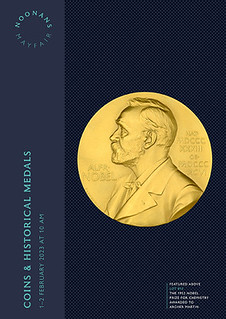 Archer's singular intellect and approach to life were evident from childhood. Unable to read at the age of nine, the breakthrough came when he was given a book about batteries and couldn't find anyone in the household to read it to him. He realised he could decode it and became a competent reader.
Archer's singular intellect and approach to life were evident from childhood. Unable to read at the age of nine, the breakthrough came when he was given a book about batteries and couldn't find anyone in the household to read it to him. He realised he could decode it and became a competent reader.
Archer suffered with stomach ulcers. During the War he was allowed extra milk as an anti-inflammatory. When his ulcer became very troublesome in later life, he was puzzled that milk then proved ineffective. Learning that pasteurisation methods had changed, he experimented with unpasteurised milk but was annoyed to find himself putting on weight. He decided to separate the milk and found the active ingredient in the whey, which he could then concentrate. He persuaded various companies to test the extract which they found effective at calming inflammation. He demonstrated this himself by burning his arms with cigarettes, but they refused to invest in his discovery because, whey being a natural product, it could not be patented.
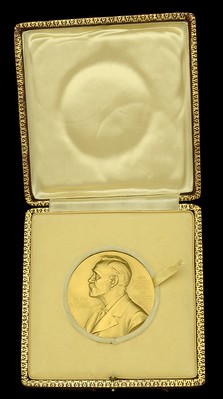 Archer's scientific legacy remains widespread today. Chromatography is a technique for separating components in a substance. Many specialised types have been developed for specific purposes and are essential tools for the life science industries. These include testing for drugs in blood, urine and breath, and the development of new drugs. They are used in the development of vaccines and their purification. In food production they analyse ingredients, toxic impurities, pesticide residues. They are relied upon for detection of pollutants in the environment, in soil, water and air.
Archer's scientific legacy remains widespread today. Chromatography is a technique for separating components in a substance. Many specialised types have been developed for specific purposes and are essential tools for the life science industries. These include testing for drugs in blood, urine and breath, and the development of new drugs. They are used in the development of vaccines and their purification. In food production they analyse ingredients, toxic impurities, pesticide residues. They are relied upon for detection of pollutants in the environment, in soil, water and air.
Archer, a teetotaller, was amused to realise his work had made possible the breathalyser.
The Nobel Prize was his most distinguished award, but by no means the only one that will be offered by Noonans in February. The full list is as follows: Nobel Laureate for Chemistry (1952), Japanese Order of the Rising Sun (1972), The Companion of the British Empire (1960), The Royal Society Leverhulme Medal (1963), The John Scott Award (1958), The Merck Connecticut University Randolph Major Medal (1979), The Mikhail Tswett Medal (1976), The Callendar Medal (1971), The Franklin Institute Medal / John Price Wetherill Medal (1959), The Fritz Pregl Medal (1985), The Jacobus Berzelius Medal of the Swedish Medical Society (1951), The John Price Wetherall Medal / Franklin Institute (1959), The Kolthoff Medal (1969).
Archer John Porter Martin, CBE, FRS (1910-2002), b. London; educ. Oaklands School Crouch End, Bedford School and Peterhouse, Cambridge; researcher at Dunn Nutritional Laboratory, Cambridge, 1933-8; moved to Leeds to work at the Wool Industries Research Association, Headingley, where, with Richard Synge, he invented partition chromatography, one of the most powerful analytical techniques ever developed for separating and identifying the components of complex mixtures, their invention in 1944 arising from research on analysing the amino acid components of wool fibre; director of biochemical research at Boots, Nottingham, 1946-8; Medical Research Council, Lister Institute, Mill Hill, London, 1948-57, appointed head 1952; FRS 1950; purchased Abbotsbury House, Elstree, with his Nobel prize money, establishing Abbotsbury Laboratories Ltd, 1959; CBE 1960; consultant to Wellcome Medical Research, Beckenham, 1970-3; professorial appointments at the University of Sussex 1973-4, Houston University 1974-9 and the E´cole Polytechnique, Lausanne, 1979-80; retired to Llangarron, Herefordshire.
Recent Nobel Prize Medals sold include: Dimitry Muratov, Nobel Peace Prize for 2021 ($103.5m, June 2022); Walter Kohn, Nobel Prize for Chemistry, 1998, ($457,531, January 2022).
For more information, see:
https://www.noonans.co.uk/
COINS AND HISTORICAL MEDALS
(https://www.noonans.co.uk/auctions/calendar/687/)
HOW TO SPOT A ‘SHORT SNORTER'
Pablo Hoffman passed along this new Atlas Obscura article on short snorters. Great photos! Thanks, -Editor
AT FIRST GLANCE, THE DOLLARS look like any others, tinted with age with some bearing the familiar visage of George Washington and others adorned with faces that aren't easily as identifiable. But upon closer inspection, these bills are covered with signatures and are taped to one another, like an odd and expensive celebratory banner. This is a short snorter,
part secret society badge and part autograph book.
The short snorter in the Air Mobility Command Museum collection belonged to Tom Farrow, a B-17 crew member of the 384th Bomb Squadron who escaped the burning wreckage of his bomber before being taken as a prisoner of war in Germany during World War II. After being rescued, he retired to Delaware and donated his short snorter to the museum, along with his diary and dog tags. It would have been rolled up for easy transport, only unrolled when a new bill or signature was added from a colleague or famous figure.
The short snorter itself is 19 bills long,
says Joseph H. Sellars, the museum's collections manager and exhibit specialist. The first four [bills] have signatures. The 10-shilling note has a list of his bombing missions and dates.
The tradition of the short snorter is believed to have started with Alaskan bush pilots in the 1920s, who would leave autographed bills in the small towns they flew into. What is certain is that it was popularized by stunt pilot Jack Ashcraft of the Flying Gates Circus after a show in Syracuse, New York, in 1925.
Ashcraft was sent to find champagne for a party but got distracted by a female companion so the next day, when he was reprimanded for his disappearance, he sidetracked his boss by asking him for two dollars. Ashcraft scrawled Short Snorter No. 1
one of the bills, initiating the man into a club of sorts (and earning a buck for his troubles). A snorter
was a shot of liquor; a short snorter
was a small amount that wouldn't put the pilots like Ashcraft over the legal limit; and a short snorter bill was evidence that you had a place among the still small number of people who had taken to the skies.
The scheme became especially popular with other pilots, who recruit members into their fold by simply taking their dollar bills and signing one as an initiation. Eventually a whole set of rules
were developed. But there was one guideline that was more important than all the rest: If you signed a short snorter and the person who owned it didn't show it when asked, they had to buy you a drink or give you a dollar.
The tradition picked up steam in the military mess halls of World War II as more people made these long-haul flights to Europe, Short snorters became a sort of good luck charm as fellow passengers signed the bills. When you filled one bill, usually a small sum, you taped onto another, including foreign currency picked up in your travels. It became a ledger of where you flew and who you flew with.
To read the complete article, see:
How to Spot a ‘Short Snorter'
(https://www.atlasobscura.com/articles/what-is-a-short-snorter)
NEW NIGERIAN BANKNOTES ENTER CIRCULATION
Pablo Hoffman of New York City passed along this article on the new Naira banknotes of Nigeria. -Editor
Pablo writes:
"An interesting behind-the-scenes look at the issuance of a new currency; collectors of modern notes might be forewarned of possible limited availability. Current official exchange rates are about 450 Naira per US Dollar, and about 750 per Dollar in the parallel unregulated market."
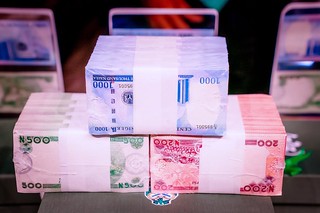 The newly redesigned naira notes will go into circulation on Thursday (today) with Deposit Money Banks releasing the bills to their customers via over-the-counter payments.
The newly redesigned naira notes will go into circulation on Thursday (today) with Deposit Money Banks releasing the bills to their customers via over-the-counter payments.
This came about three weeks after the President, Major General Muhammadu Buhari (retd), unveiled the new bills at a weekly Federal Executive Council meeting in Aso Rock Villa.
The President unveiled the redesigned notes across the N200, N500 and N1,000 denominations.
The Governor, Central Bank of Nigeria, Godwin Emefiele, had in October announced that apex bank would release re-designed naira notes by December 15, 2022.
He also disclosed that the old notes would cease to be regarded as legal tender by January 31, 2023.
Emefiele pointed out that the redesigning of the naira notes would help to curb counterfeit notes, and reduce ransom payments to terrorists and kidnappers.
The CBN boss said it was worrisome that 85 per cent of the total currency in circulation was being hoarded by Nigerians.
As such, he said the redesigning of the local currency would help to mop up the currency outside the banking sector, adding that out of about N3.3tn in circulation, close to N2.75tn were outside the banking sector.
However, some bank officials claimed the amount of the new notes available to the various bank from the CBN was small.
According to them, most OTC payments will still have to be made using the old notes because the amount of the available new notes is still small.
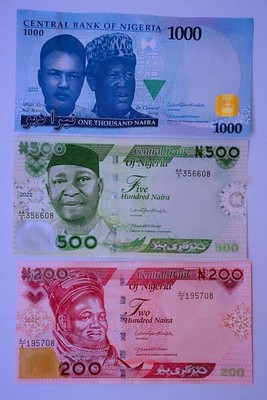
The amount given to us is small compared to what we need. For example, what is available to my branch is less than N1m. This is nothing compared to what we need. But I believe it will increase with time,
an official of FCMB in Lagos who pleaded anonymity told one of our correspondents.
Meanwhile, findings from the CBN show the total amount to be released into circulation may not be much as the sum previously in circulation.
A top official of the CBN, who spoke on condition of anonymity, said the CBN was planning to increase electronic payments and not cash transactions.
Don't expect that there will be a large circulation of the new notes in the economy. There are different electronic channels that people should be using.
Pablo included the above illustration of the notes. -Editor
To read the complete article, see:
Banks reconfigure ATMs, new naira enters circulation today
(https://punchng.com/banks-reconfigure-atms-new-naira-enters-circulation-today/)
To read the earlier E-Sylum article, see:
NIGERIANS UNIMPRESSED WITH NEW BANKNOTES
(https://www.coinbooks.org/v25/esylum_v25n48a27.html)
JAMAICA LAUNCHES NEW BANKNOTES
Jamaica is also launching a new series of banknotes. -Editor
For only the second time since Independence, Jamaica has introduced a new series of banknotes, which are set to be released on a phased basis in 2023.
The Bank of Jamaica (BOJ) on Thursday, December 15, launched the revamped series developed on polymer substrate, which the central bank says is more durable, resulting in cost savings and a longer-lasting product. BOJ officials said that the purpose of the launch was to show the notes as being ready.
Printed by banknote printers De La Rue, the new notes are JMD 50 (US $0.33), JMD 100 (US $0.65), JMD 500 (US $3.26), JMD 1,000 (US $6.51) and JMD 5,000 (US $32.57) plus a sixth, the JMD 2,000 (US $13.03), which was introduced. The 2,000 note is being introduced in order to make it easier for the settlement of cash transactions.
Deputy Governor Natalie Haynes said at the launch that new security features were more on the higher value notes, noting as well that because the new polymer notes were more durable, the bank no longer expected to order new notes printed every year.
BOJ Governor Richard Byles said, The notes will enter circulation on a phased basis in 2023,
with it being otherwise noted that distribution is set for the period January to June.
A De La Rue representative present at the launch stated that moving to polymer significantly reduces counterfeits. Haynes, in response to queries, declined to disclose further security features, stating that these will be part of a public education campaign to come.
Byles said that the new issue also addressed the confusion addressed by users about the 500 and the 5,000 banknotes not being easily distinguishable from each other. The redesign, he stated, addresses this, as well as improving efficiency and providing cost savings.
Officials at the launch noted that notwithstanding use of digital currency Jam-Dex, cash remains important. According to the central bank, as of November 16, there were 252 million pieces of notes in circulation in Jamaica with a total value of JMD 198.3 billion (US $1.29 billion). Of that, the majority JMD 161.75 billion (US $1.05 billion) is in the hands of the public, while JMD 43.2 billion (US $281 million) is held in banks.
The BOJ indicates that an equivalent amount of new series is available to replace the current series. Note, however, that the current series of banknotes will remain legal tender until Bank of Jamaica makes a decision regarding demonetisation of the same.
To read the complete article, see:
New currency launched with improved security features
(https://www.thedailyherald.sx/regional/new-currency-launched-with-improved-security-features)
THE GREAT BOOK DEACCESSION
Here's a Washington Post article for bibliophiles, on a world drowning in old books. -Editor
Books are precious to their owners. Their worth, emotional and monetary, is comparably less to anyone else.
Humorist and social critic Fran Lebowitz owns 12,000 books, mostly fiction, kept in 19th-century wooden cases with glass doors in her New York apartment. Constitutionally, I am unable to throw a book away. To me, it's like seeing a baby thrown in a trash can,
she says. I am a glutton for print. I love books in every way. I love them more than most human beings.
If there's a book she doesn't want, Lebowitz, 72, will spend months deciding whom to give it to.
I kept accumulating books. My life was overflowing with books. I'd have to live to 150 to reread these books,
says Martha Frankel, a writer and director of the Woodstock Bookfest. She amassed 3,600 — and that was just in the office that she closed in 2018 — but the idea of getting rid of these books made me nauseous.
America is saturated with old books, congesting Ikea Billy cases, Jengaing atop floors, Babeling bedside tables. During months of quarantine, book lovers faced all those spines and opportunities for multiple seasons of spring cleaning. They adore these books, irrationally, unconditionally, but know that, ultimately, if they don't decide which to keep, it will be left to others to unceremoniously dump them.
And so, despite denial, grief, bargaining, anguish and even nausea, the Great Deaccession commenced.
This is the most material flooding onto the market that I've ever seen,
says veteran Vancouver, Wash., dealer KolShaver, a sentiment shared by sellers across the country. For dealers who survived the pandemic, the used-book business has never been healthier,
says Wonder Book owner Chuck Roberts, a 42-year veteran in the trade, strolling through his three-acre warehouse, a veritable biblio wonderland, jammed with volumes ranging from never-been-cracked publishers' overstock to centuries-old classics bound in leather.
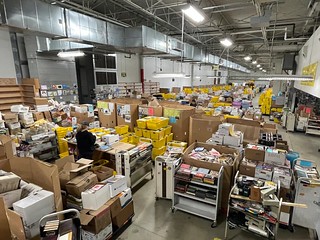
We take everything and pretty much what no one else is going to take,
Roberts says, which is how his business accumulated an inventory of 6 million, with 300,000 more new used books arriving every month. Wonder Book practices nose-to-tail bookselling,
meaning a home or use is found for each item one way or the other through multiple internet sites (national and international), three brick-and-mortar stores, school and charitable donations. Wonder Book's damaged items on life support are pulped to produce 100,000 pounds monthly of recycled paper.
Despite the advent of the digerati and eBooks, hardcovers and paperbacks continue to flood the market for readers who prefer the look and feel of physical books, the weight in their hands, the pleasure of turning a page. Three-quarters of trade book revenue last year derived from hardcover and paperback sales, according to the Association of American Publishers.
What to do with old books is a quandary that collectors, no matter what age, eventually face — or leave to their heirs who, truly, do not want the bulk of them.
Most people haven't a clue as to how many books they own. Possibly, they don't want to know. Roberts routinely make house calls to owners claiming to own 2,000 books only to discover a quarter of that.
Or vice versa. Drexel University law professor Clare Coleman thought she owned 1,300 books until her book group reminded her that she owned twice that many, given that her Billy shelves were stacked two deep.
To read the complete article, see:
We're drowning in old books. But getting rid of them is heartbreaking.
(https://www.washingtonpost.com/lifestyle/2022/12/19/used-books-stores-donation-fran-lebowitz/)
LOOSE CHANGE: DECEMBER 18, 2022
Here are some additional items in the media this week that may be of interest. -Editor
Here's a report on the sale of Forrest Fenn's treasure. -Editor
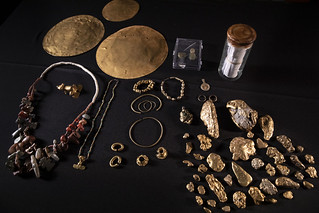 The online auction of items from Forrest Fenn's famed treasure chest closed on Tuesday. In total, the sale generated $1,307,946.
The online auction of items from Forrest Fenn's famed treasure chest closed on Tuesday. In total, the sale generated $1,307,946.
All 476 artifacts in the collection were sold, and a total of 1,643 people placed bids for a piece of the fortune, Heritage Auctions communications director Robert Wilonsky told Outside.
A 549-gram Alaskan gold nugget brought in the most cash, with the highest bidder taking it home for $55,200. The next highest price was for a wax-sealed glass jar purportedly containing Fenn's 20,000-word autobiography, which went for $48,000. In his 2010 memoir The Thrill of the Chase, Fenn wrote that he included the autobiography because maybe the lucky finder would want to know a little about the foolish person who abandoned such an opulent cache.
The sale is yet another wrinkle in the saga sparked by Fenn in 2010, when the late art dealer hid the chest filled with gold and jewels somewhere in the Rocky Mountains. Obsessives searched far and wide in pursuit of the riches, with a 24-line poem as their only clue. One man served time in prison for digging up graves at Yellowstone National Park. Five people died while looking for the cache.
To read the complete article, see:
Forrest Fenn's Treasure Sells for Less than a Condo in This Mountain Town
(https://www.outsideonline.com/outdoor-adventure/exploration-survival/forrest-fenn-treasure-sold-online-auction/)
To read the earlier E-Sylum article, see:
FORREST FENN'S TREASURE CHEST OFFERED
(https://www.coinbooks.org/v25/esylum_v25n47a18.html)
A CoinWeek article by Michael Shutterly examines coins of the Iconoclasts. -Editor
Iconoclasm (image smashing
) was very popular within the Byzantine military during the eighth and ninth centuries, but the bulk of the population strongly opposed the Iconoclasts (image smashers
). The decree of the Second Council of Nicaea in 787, which declared Iconoclasm to be heretical, was well-received throughout most of the Byzantine Empire. Iconoclasm was a lost cause.
Or so it seemed.
To read the complete article, see:
CoinWeek Ancient Coin Series: Coins of the Iconoclasts, Part II
(https://coinweek.com/ancient-coins/coinweek-ancient-coin-series-coins-of-the-iconoclasts-part-ii/)
This one's non-numismatic, but seasonal. It's about the history of that ubiquitous holiday decoration, the snow globe. -Editor
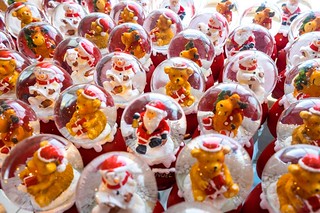 AS THE CLASSIC FILM CITIZEN KANE opens, Charles Foster Kane lies in bed, alone in the dark clutching a snow globe. Inside the globe is a wooden cabin covered in white. After a minute, Kane whispers one of the most famous lines in film history—just one word—
AS THE CLASSIC FILM CITIZEN KANE opens, Charles Foster Kane lies in bed, alone in the dark clutching a snow globe. Inside the globe is a wooden cabin covered in white. After a minute, Kane whispers one of the most famous lines in film history—just one word—Rosebud.
His hand goes limp, and the glass globe falls to the floor and shatters. It's an iconic image—but it is one with some mystery. No one knows for sure who made Kane's snow globe. In the absence of certainty, credit has been given to the Original Snow Globe Factory and the family who gave the world these wintery miniatures.
The story begins around 1900 when Erwin Perzy, a surgical instrument maker in Vienna, Austria, received a request from a doctor for a lightbulb that produced the bright illumination needed for surgery. At first, Perzy thought he could solve the problem with a shoemakers' lamp, a glass globe filled with water that, when placed in front of the lightbulb, amplified and focused the light on the work area. While helpful, the light was too focused on one small spot and thus, not practical for surgery.
To read the complete article, see:
This Family Gave the World the Snow Globe
(https://www.atlasobscura.com/articles/who-invented-snow-globe)
INTAGLIO AUTO TITLE PAPER SHORTAGE
The Wall Street Journal reports on the latest shortage of title paper, which is slowing auto sales. The situation is no surprise to E-Sylum readers - we discussed this back in 2015 following an Ohio-based company's closure. -Editor
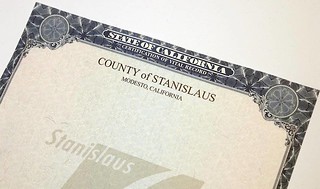 Supply-chain snarls have hit one of the most boring documents in anyone's filing cabinet—the car title.
Supply-chain snarls have hit one of the most boring documents in anyone's filing cabinet—the car title.
When I first heard of this, I said, ‘What?'
recalls Bob Wheat, general manager at Village Ford car dealership in Dearborn, Mich. It was just a total surprise to me.
Already, the auto industry has dealt with crimps in supplies of chips, batteries and even the oval blue badges that Ford Motor Co. puts on trucks.
Now, some states are warning that the specialized paper used to print vehicle titles has gotten hard to find. Government agencies are rationing stashes and extending wait times for flummoxed dealers and car owners.
The problem isn't with the states that issue the documents. It is with the companies that make the paper, which contains features such as watermarks and security threading to prevent counterfeiting. Consolidation in the industry has reduced the number of companies making it.
Dealers usually need titles to transfer ownership to buyers, and car owners need them to prove legal ownership when they register them, resell them or trade them in. Insurance companies typically require them to process claims.
These days, Mr. Wheat says, he has to be careful not to buy vehicles from other dealers unless they can produce a title, not wanting to get stuck trying to get one himself. Without a title, the car can end up sitting on the lot collecting dust.
Title paper may be the least flashy paper around. No one says, Oh, I've got to title-wrap some presents.
Even title paper's initials, T.P., are already taken—by bathroom paper.
It's one of these things that's like everybody's touched it probably at some point but you don't realize the complexity that actually goes behind it,
says Andrew Palmer, director of sales for labels and forms at R.R. Donnelley & Sons Co., one of the largest printers of title paper.
State officials in Michigan, South Dakota and Oklahoma have taken steps to conserve supplies, including giving priority to buyers who require a title to sell a vehicle, and asking dealers to hold off on applying for a title until after a purchase is final, the officials say.
Michigan's Secretary of State, the entity that handles titles, has gotten more paper in recent months and is considering switching to different paper types to avoid future problems, according to a spokesman.
Some two dozen states, including Texas and California, are using more digital vehicle titles, reducing their need for the paper.
Some users began stockpiling the paper, straining mills already struggling to meet orders, says Paul Schweitzer, president of CompleteSource Inc., which prints vehicle titles for several states.
In my 40 years, I've seen shortages and lead times,
he says, but nothing like it is now.
To read the complete article (subscription required), see:
Now Driving You Mad at the Car Dealership: A Shortage of Title Paper
(https://www.wsj.com/articles/supply-chain-shortage-car-automotive-titles-11670770079)
To read the earlier E-Sylum article, see:
COUNTY INTAGLIO PRINTING PAPER SHORTAGE ENDS
(https://www.coinbooks.org/esylum_v18n49a34.html)

